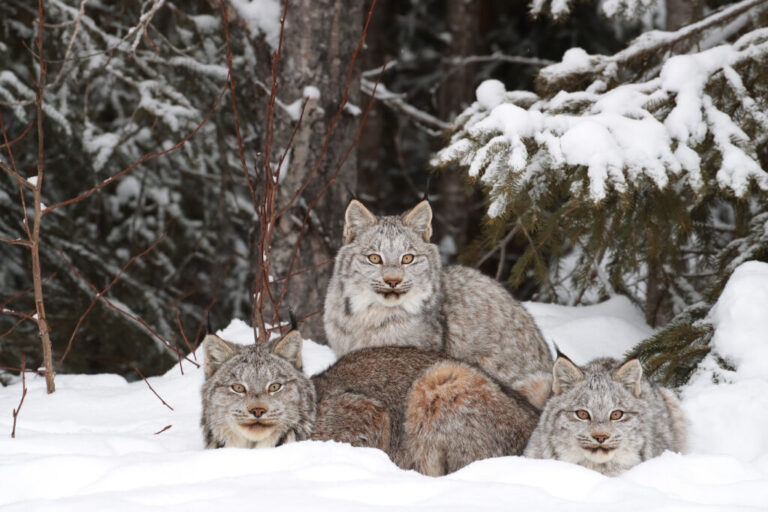High School Physics Photo Contest
Held by American Association of Physics Teachers(AAPT)
Learn about the physics behind natural and contrived situations by creating visual and written illustrations of various physical concepts
Introduction

It is a competition held by AAPT, where competitors are required to take a photo which reflects a physics phenomenon, along with a maximum 250 words description of the photo. This contest provides teachers and students with the opportunity to learn about the physics behind natural and contrived situations by creating visual and written illustrations of various physics concepts.
Challenge Rules
Competitors
Grade 9 - 12, IGCSE to A-LevelCategories
- Natural photos are those that involve everyday situations that may demonstrate a variety of physics concepts.
- Contrived photos are those that are set up to show a particular physics concept or related set of concepts.
Requirement
- Photos may be entered in one of two categories: natural photos or contrived photos. Descriptions must be fewer than 250 words. The description should have a title and must be written by the student.
- Jpeg file of High Resolution photo - can be printed to 8” x 10”or 8½” x 11”(at least 800w resolution)
- Photos with multiple images or other computer manipulation are not acceptable.
Judging Rules
A committee of physics teachers will select Top 100 from the submitted photos . (Marking: approximately 40% on the description and 60% on the photograph). The top 100 photos (50 Contrived, 50 Natural) will be displayed and judged at the next AAPT Summer Meeting to determine the final winners.Awards
Global Award- Natural photos: Top 3 winners
- Contrived photos: Top 3 winners
- Global Top 100
- National Top 50
Registration deadline:
May 7, 2025Online registration
http://www.seedasdan.org/AAPTPHOTO_en.jspWinners( in China)
Natural
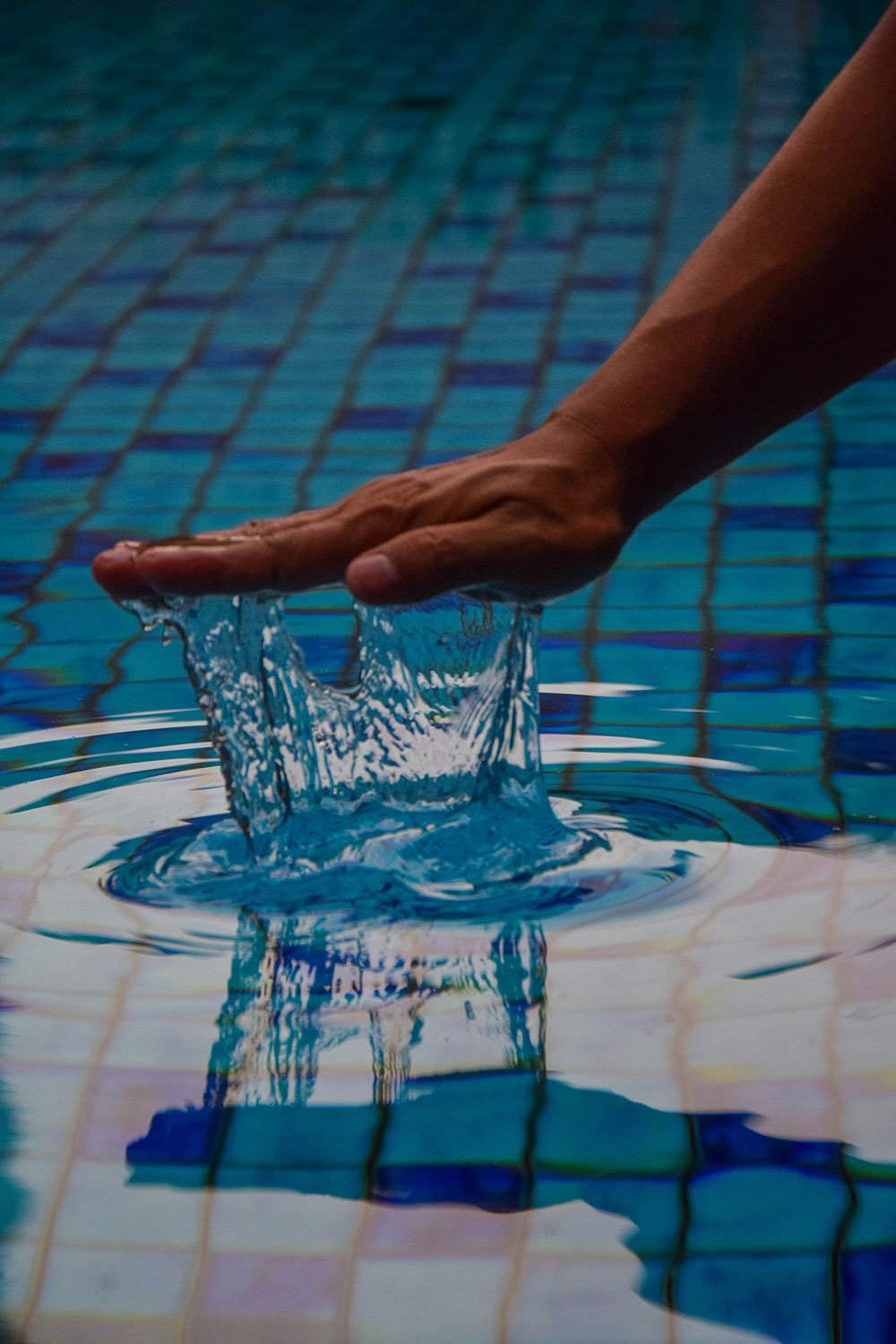
Water Adhesion
Water a common thing but also indispensable for every living creature, it is inevitable for the human to interact with water, but have we discover the interactions in detail? One of the cool phenomena between water and human is that water sticks with our skin for a short period when we withdraw our hand from the water. This phenomenon appears because of surface tension and adhesion, which are two common physics phenomena. Water has strong surface tension, and the reason why water has this property is that of cohesion. Cohesion bonds the water molecules on the surface, which creates a layer of connected water. Furthermore, when we put our hand into the water, water will bond with our skin and is called adhesion. With these two physics properties, while the hand withdraws from the water, the water molecules will be carried by the hand, and also the cohesion between water molecules will carry even more water from the hand’s withdrawal. As a result, water will stick with human’s hand for a short period when it is withdrawn from the water.
全球自然类第三名
—— YANG JIANG
Natural
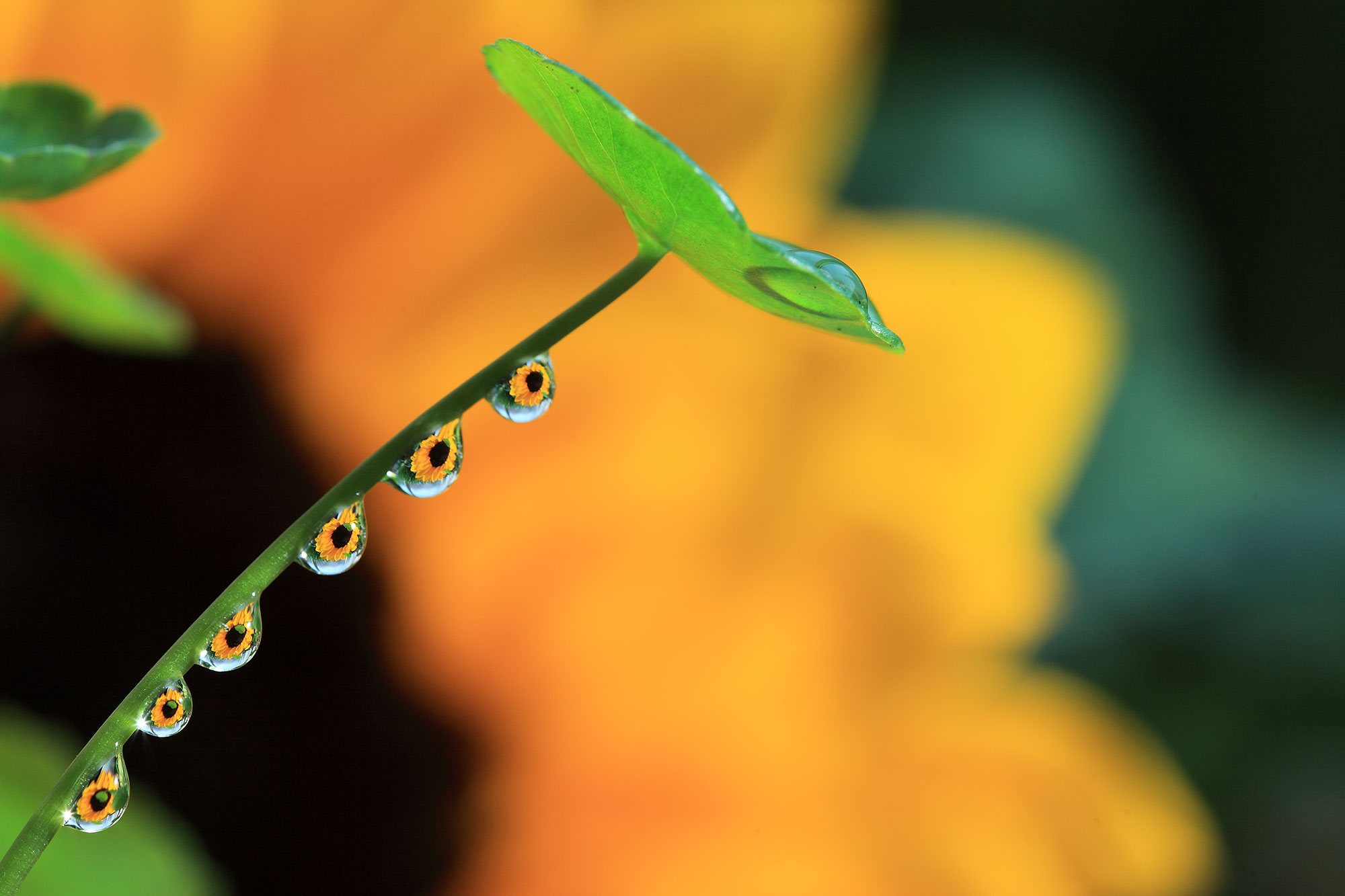
Magic Light
Penny grass is a tiny, umbrella like grass. which cannot live without water. I took this picture just after it was watered in the morning. I was deeply impressed and attracted. It is colorful and glittering. The flowers in the droplet of water were formed by the refraction of light. This is a perfect example of the path changing of the light rays due to the different index of refraction of air and water. when light passed from one transparent medium into another, part of the incident light is reflected at the boundary. The rest changed their directions.
The droplet is not a perfect spherical one owing to the gravity. It is much more like one planoconvex lens. The diameter is only half a centimeter around. The incidence light first reflected from the real flower into the water and changed direction and focused on the focal point to form the image. The droplet just like a convex lens. The position of the real flower and the droplet should be parallel to each other to get a clear and complete real image. We can see a sharp image, when the eye is placed behind the image.
The sunflower is real and has three dimensions, so the focal planes are not only one. That is why the images are not quite the same as the object. The real images are upside down which can be explained by tracing the ray. The size of the image is depends on the distance between the flower and the droplets according to the lens equation.
The beautiful flowers in the droplets can be seen is the coincidence of the right incidence angle of light, the right angle of my eyes. when I moved slightly, it disappeared like a magic. Beauty is everywhere, for our eyes, not the lack of beauty, but the lack of discovery!
全球自然类一等奖
—— YINING LU
Ripple
The photo shows that there are three ducks are swimming on the lake at the same time. It indicates two common physical phenomena.
The first one is called interference of waves. Since the three ducks (wave source) are swimming in the same speed, the frequency is approximately identical. It is obvious that some vibrations are much stronger than the others, because the peaks of these waves combine together. It makes the amplitude much larger than normal cases. On the other hand, this phenomenon can also be called the constructive interference. When the constructive interference occurs, the destructive interference should also happen simultaneously. In this case, you can see the interference wave pattern is having less amplitude.
The second phenomenon occurs in the photo is reflection. It represents a common sense of physical phenomenon of light. If you zoom in the photo, you can clearly see the reflection of the heads of three ducks on the surface of lake."
—— QINGHUA XIAO
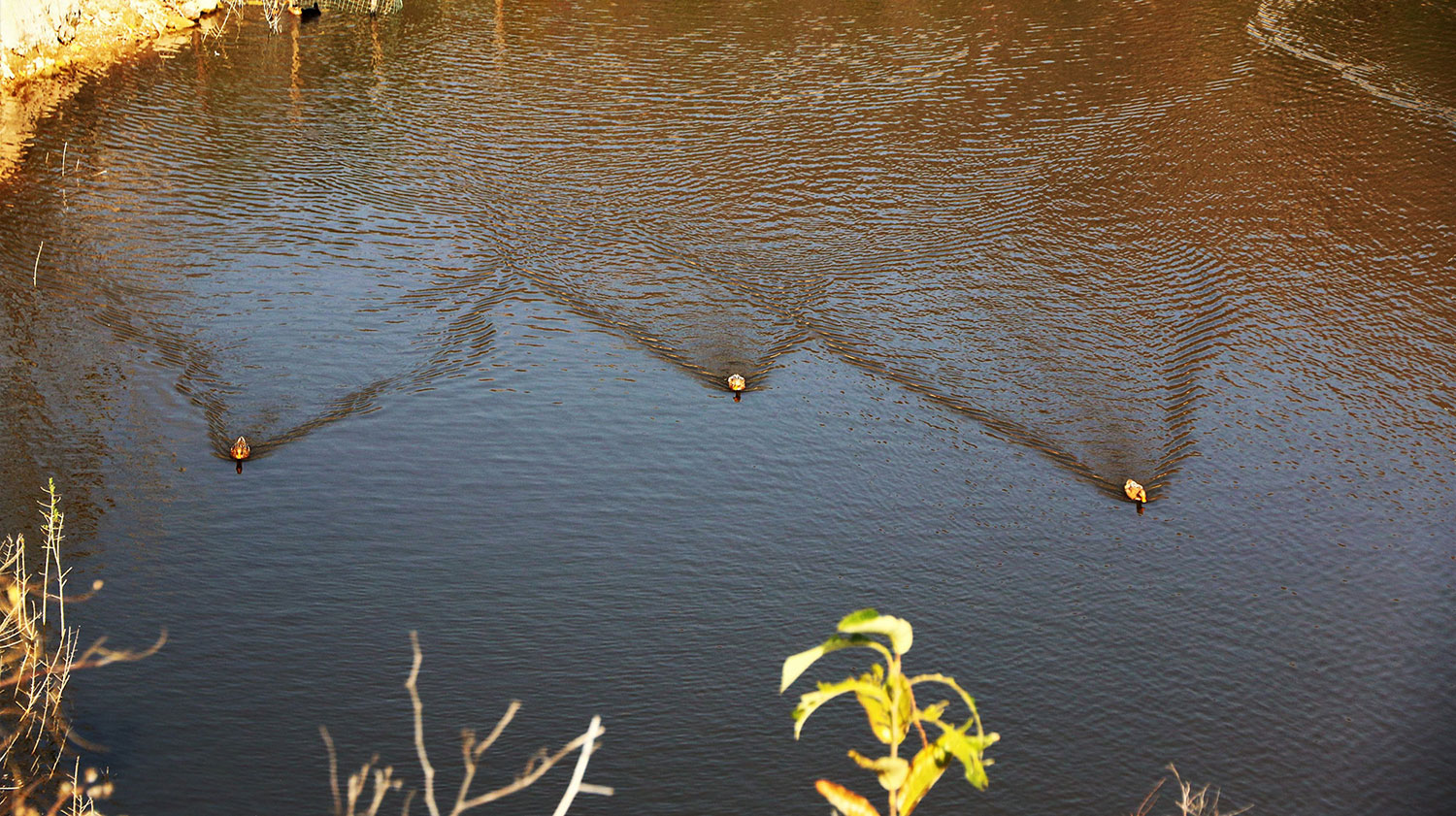

The Natural Scenery
In this picture, the physical phenomenon that occurs is reflection.Reflections on still water are an example of specular reflection.Specular reflection, also known as regular reflection, is the mirror-like reflection of waves, such as light, from a surface. In this process, each incident ray is reflected, with the reflected ray having the same angle to the surface normal as the incident ray. The result is that an image reflected by the surface is reproduced in mirror-like (specular) fashion. The law of reflection states that for each incident ray the angle of incidence equals the angle of reflection, and the incident, normal, and reflected directions are coplanar.
—— JUNYANG CAI
Contrived
splashed water turned into ice
This photo was taken at the Bashang Grassland. The temperature was very cold. When the sun rised, it was around negative 20 degree Celsius. When I splashed hot water from a cup, it turned into small ice crystals in the sky immediately. The reason why it freezed so fast is that hot water evaporates faster than cold water. So it turns into small water droplets easier. Thus, the water droplets become ice crystals in a very short period of time. Low temperature environment and hot water together form this amazing scene!
全球设计类三等奖
—— LUANYIN HUANG
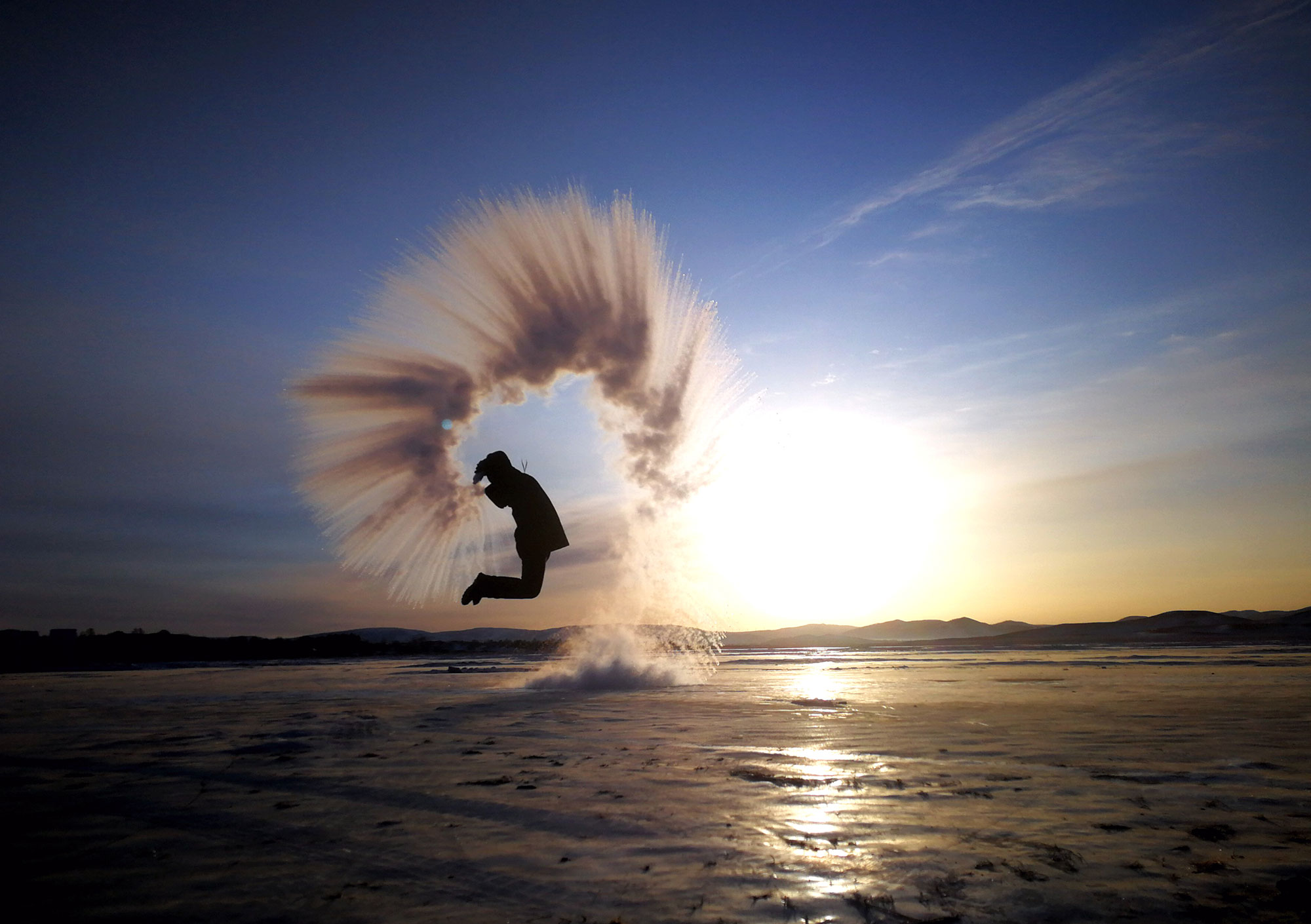
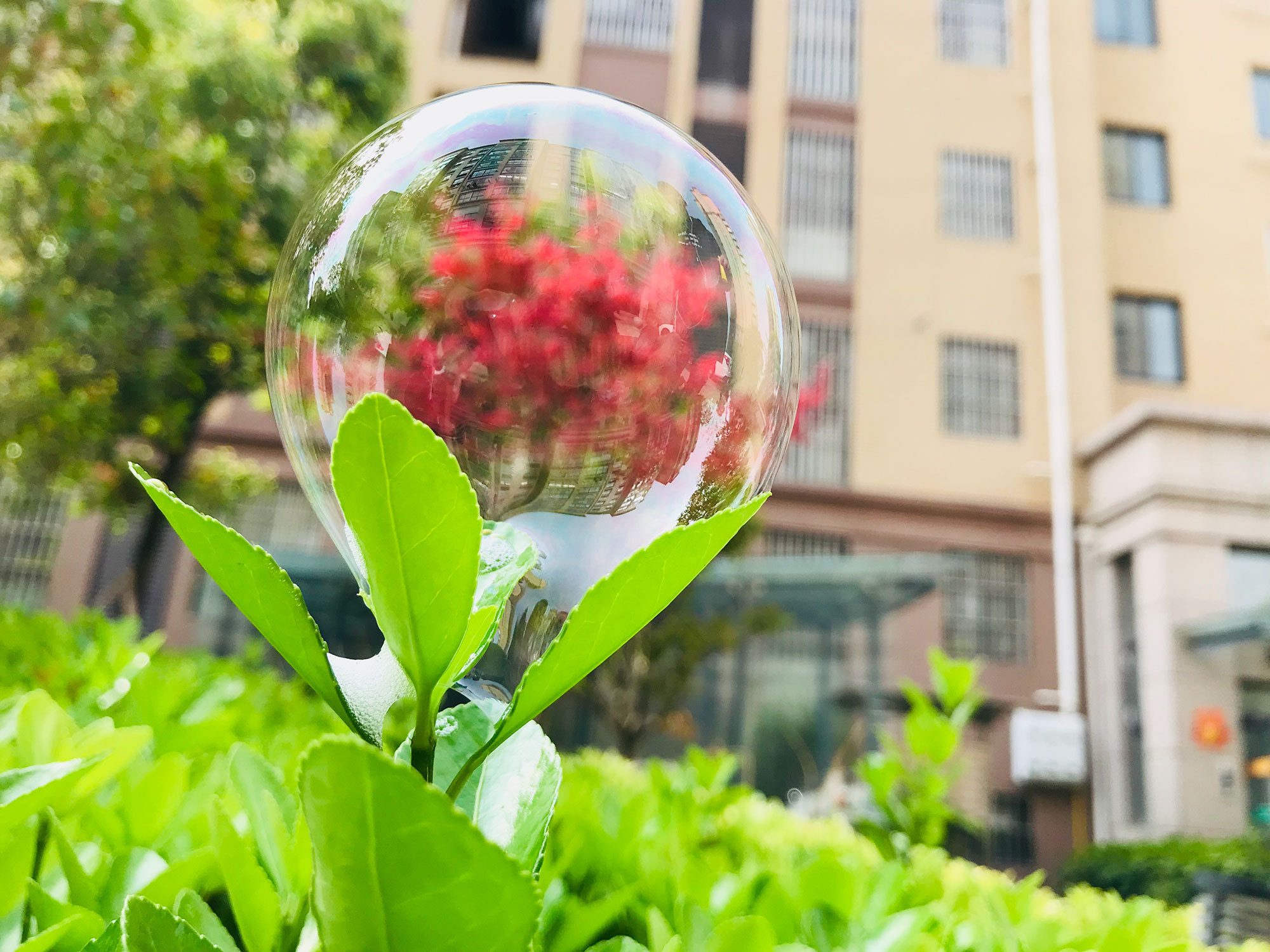
Spring in bubble
On a sunny but windy day,a bubble fell on the leaves.Because of the surface tension of the liquid,the bubble wasn’t broken and stayed on the leaves.This hollow bubble was like a crystal ball.Because of the imaging principle of converging lens,a red tree and houses were shown inside the bubble.But the beauty was only in a flash. The bubble was broken with the blowing wind.Good things are always easy to lose.However,as long as we are good at discovering beauty,beauty is eternal.
—— SHANSHAN SONG
Hard and fragile.
The tears of the material is very hard, it can withstand the pressure of the 8 tons, but only some of the pressure at the rear of it, it will be crushed. When the molten glass drops into cold water, the surface of the glass cools quickly to form a shell, but inside it is still liquid. Wait for internal cooling is limited by the shell volume shrinkage, lead to the internal and surface molecules pulling each other, make the surface molecules become more compact, so the glass head very hard, when external damage, these residual stress is released quickly, the crack spread across all then completely shattered. This beautiful "teardrop" is "hard and fragile" because of its physical properties.
—— YUYUAN SHAO
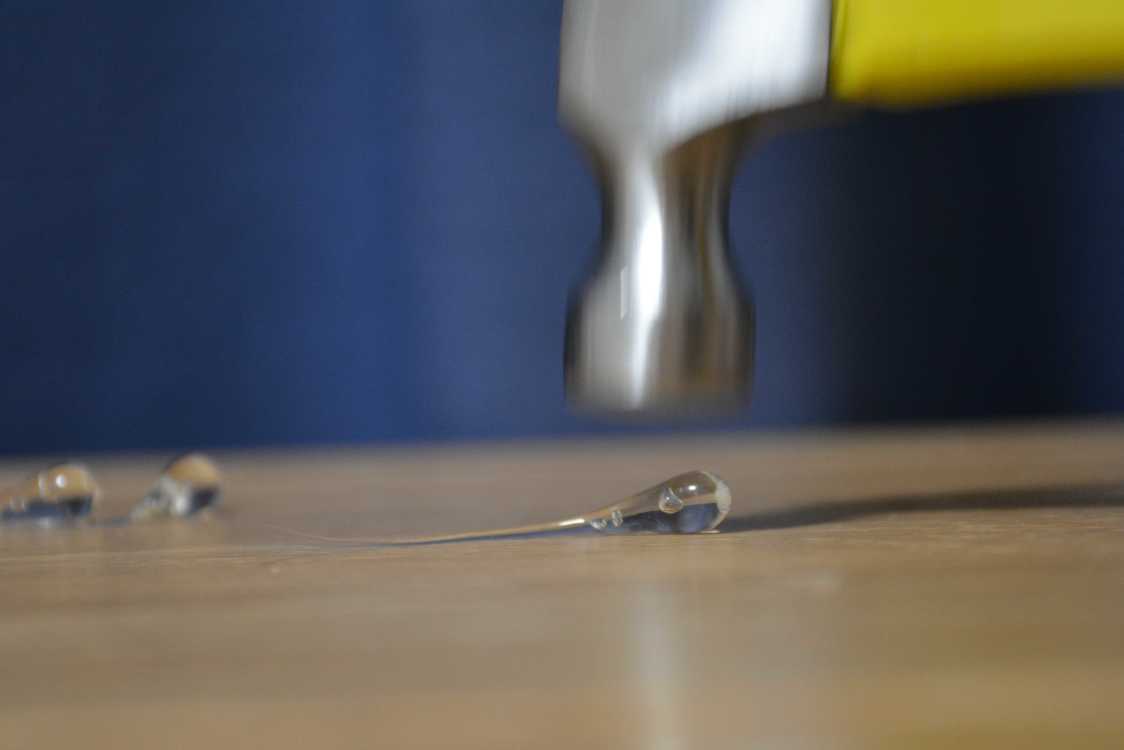
Natural
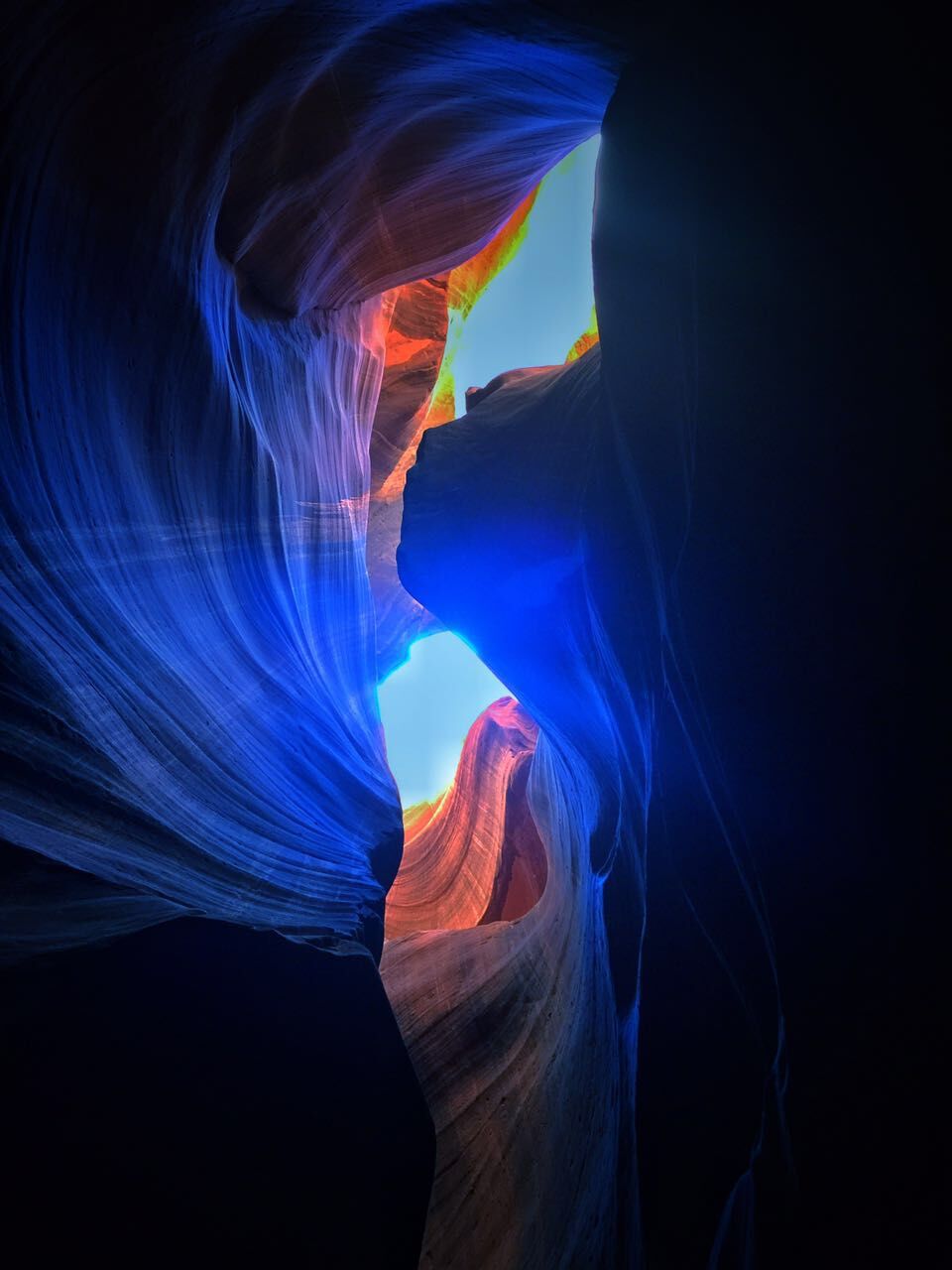
The world is a beautiful place full of natural phenomena that can be explained by simple physics. I took this photo at the Antelope Canyon when I visit America last year. The Antelope Canyon is a very beautiful place and it is one of the world’s most wonderful landscapes. This canyon is the Type slot canyon that means the it is very narrow. As you see the photo, you can see light travel through the two sides. If you look closely, you can see many kinds of different colors. It can be explained by the dispersion. It can separate white light into its component colors. These colors and their order represent visible light on the electromagnetic spectrum. In the junction of the cave and outside, the bright color are near to the outside and the dark color are near the inside cave, that’s because they have different wavelength. I can’t forget this place in my whole life.
—— 1. JUNYANG CAI
We say that we never abandon ourselves to despair as long as the sun shines and pierced the darkness. This photo, that taken in a well which locates deep underground has become a sign of life for me. Life just go on day and day, just like the sunshine through the well do. So I name this photo” LIGHT IN THE DARKNESS”.
Looking down at the bottom of the well, we can only to see the darkness. But lift your head, you can see another wonderful world. We marvel at the azure sky we see. In fact, this can be explained from a physical point of view. The sunlight include seven kinds of visible light (red, orange, yellow, green, blue and purple) and invisible light such as infrared and ultraviolet. When the sunlight passes through the atmosphere, the red light with longer wavelength has the strongest transmission capacity, followed by orange, green and so on. While the shorter wavelength (violet and blue) lights’ ability of transmission is weak, the airborne suspended particles have more impacts on them, let them scattered in all directions. Thus, we saw the sky so blue.
Also we can see light lit up the hole. Because light travels in straight lines in uniform mediums. However we can still see the ladder next to the hole clearly, that is due to the reflection of light on the surface of the ladder, and the light reflected into our eyes. Thus we are able to enjoy the exquisite universe.
—— 2. YIYANG GUO
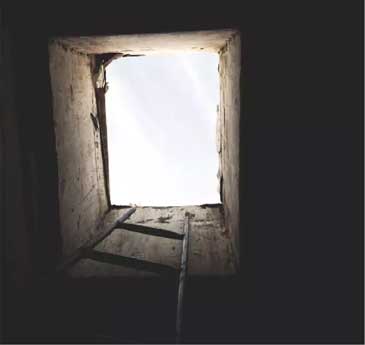
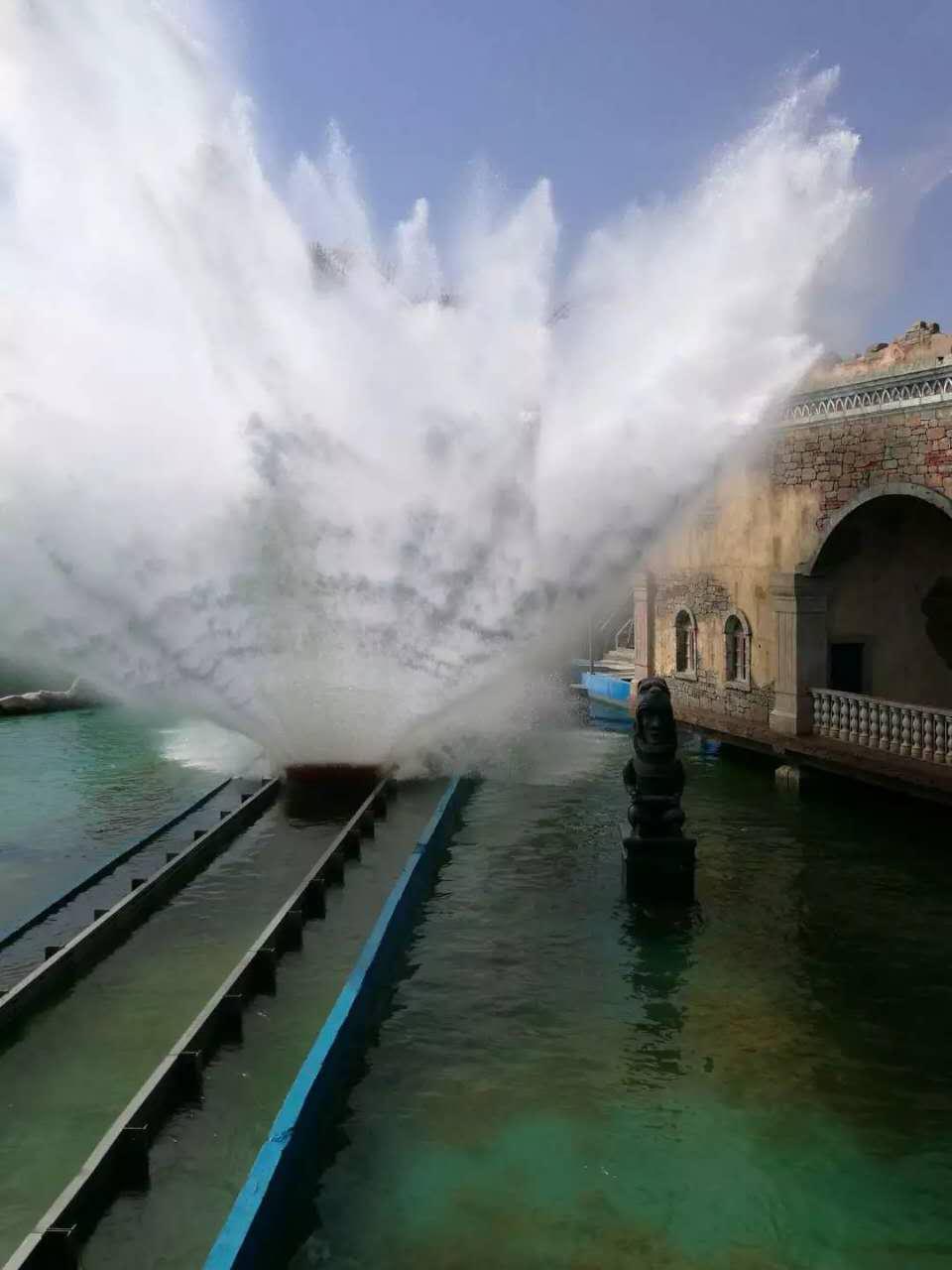
This picture was taken in an amusement park. After I played the roller coaster I took this photo. As you can see, when the roller coaster rushed into the water, the water splashed up, and the color of water changed from colorless to white. So why will the color turn white? That is because sunlight is mixture light. It has seven colors and every color has different wavelength. Water droplets is formed by the water collision , and each drop can have well light refraction, when every color be together. So it well make water looks white.
—— 3. YUHAN SHI
Contrived
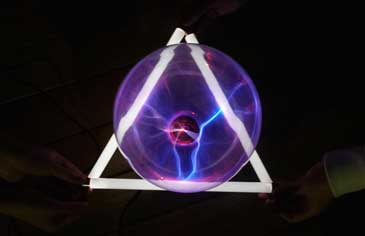
This picture shows the light tubes being illuminated by a plasma magic globe. The hands hold the three tubes near the surface of the magic globe. The plasma magic globe is a clear glass sphere filled with a mixture of various noble gases with a high-voltage electrode in the center of the sphere. The high-voltage electrode forms an electric field around the globe and emits electrons. With the electric force, the electrons accelerate and collide with the atoms of the gas. The atoms are ionized into negative and positive ions, forming filaments. Plasma filaments extend from the electrode to the glass insulator, giving the appearance of multiple beams of colored light. When putting the fluorescent tubes close to the plasma globe, there is a potential difference between the hands which hold the tube and the high-voltage electrode, as hands are conductors connected to the ground. A strong electric field is formed in the tube, and breaks down the gas inside the tube. Thus the tubes are luminous. Without contacting the surface of the ball, the tubes can still be luminous as there is an electric field around the magic globe (there is potential difference).
—— 1. CHENDAN LUO
Amazing physics phenomenon happens every moment in our daily life. This photo was captured under the hexagon light in the library. It shows colorful and infinite reflections of light inside the lens. The mirrors of the SLR(single lens reflex) camera create an optical illusion of infinite patterns of hexagon lights inside an extended space. The optical components of a typical SLR camera offer the way light passes through the lens assembly, which contains at least two mirrors parallel with each other and reflect lights. Part of the light source are reflected backward whereas part of it directly go through the mirror and are reflected back again by the second mirror. Again and again, countless patterns of light are reflected back to our eyes, therefore we can see infinite optical patterns with the shape of hexagon. In addition, it gives us the gradually diminished sizes of the pattern, that is they are farther and farther from us when we look inside the lens. In fact, based on the principle of the plane mirror reflection, the sizes and distances between each two patterns are the same, so it is only an illusion rendered by our eye structures.
—— 2. TONGXIN LI
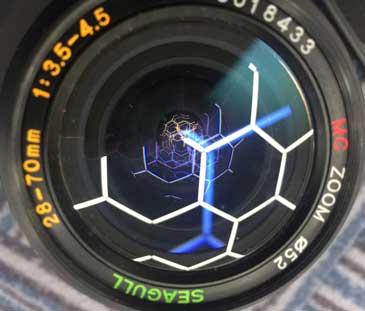
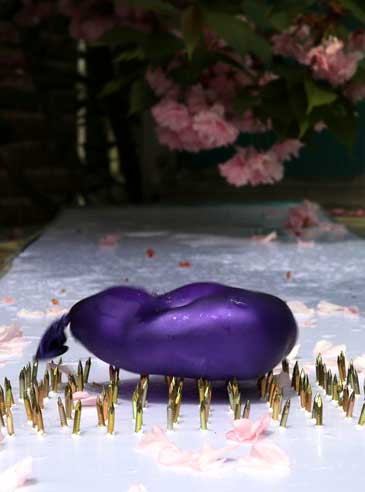
From this picture, it can be surprisingly observed a large water-filled balloon bouncing on a bed of nails from a height which can provide sufficient large impact velocities, and no burst. This impact could always be separated into two phases: spreading and retracting, and the picture is taken at the instant when the balloon touches the nails. The instantaneous shape looks similar as a pancake. This unique fluid mechanics phenomenon can be explained by the theory of 'pancake bounce' in the macroscopic version. The balloon is like a droplet, and the bed of nails is like the hydrophobic material. During the spreading process, the balloon undergoes an inertia-dominant acceleration and spreads into a 'pancake' shape. Only when the balloon material that is forced into the nail pattern recoils with sufficient energy, the balloon lifts off the surface before it retracts. In addition, super hydrophobicity models show that the contact area between the water-filled balloon and the surface is extremely small. When the fraction of solid surface area wet by the liquid is smaller, then the hydrophobicity, which is similar to the ability that makes the balloon bounce, will be larger. In this way, when the water-filled balloon impacted the nails, part of the balloon would fall in to the intervals of nails, and received the elastic force to retract by the surface of balloon cover forced. Then the balloon bounced back immediately just like a spring as the shape of pancake.
—— 3. ZICHEN ZHANG
Natural
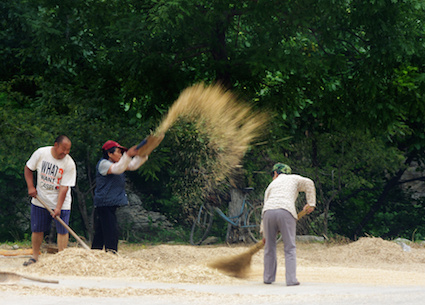
It was a weekend in June last year. I went to visit my aunt. She was winnowing the chaff from the grain. And then I took this photo. This photograph reflects the inertia of objects. My aunt used the winnowing fan to throw up the grains and chaff into the sky. When they fell to the ground, the distance between grains and my aunt was farther than the distance between chaffs and my aunt. Look at this photo, you can see that these radial lines are grains and khaki points are the dropping chaffs. This phenomenon is because of inertia. My aunt gave both grains and chaffs an initial velocity to remain moving in the sky. They both received a gravitational force. The mass of grains is larger than chaffs. So the inertia of grains is larger than chaffs. As a result, it’s harder to change the moving state of grains. And finally, chaffs and grains are divided.
—— 3. Yuxin Zhang
That world is such a beautiful place where the nature process is everywhere. During the time I went to the United States this winter vacation, I saw the beauty of the nature on the plane. The heat in the atmosphere is a result of the long wave radiation from the ground, which means the temperature is lower near the earth, Instead of directly coming from the sun. The measurements show that air temperature drops by 0.6℃ (33.08℉) for every 100 meter rise in elevation. Most of the times, the planes fly 30,000 feet above the ground, so the approximate temperature will be -40 degrees centigrade (104℉). At this time, since the temperature is lower than the freezing point (0℃ at STP) and there is moisture in the air, it will form the snow. Actually the pic is not so clear as what I saw. What I saw using the portable plastic magnifying lens is that each snow is a separate part. At the same time, I found that the snow were mainly around the hole on the middle window, which is the bleed hole on the down side of each window on the plane. According to what I searched in the library, the hole is designed to keep the frost and fog away, and it's used to balance the air pressure between the passenger cabin and the exterior and middle layer of the window. But the down side of that design is just what shows in the picture, it will cause the convection of air and might form the snow. That's what I thought on the airplane and what I thought after that. I thought that the beauty of the nature is everywhere, and just need our eyes and ears and feelings to experience them!
—— 4. Shunzhe Ma

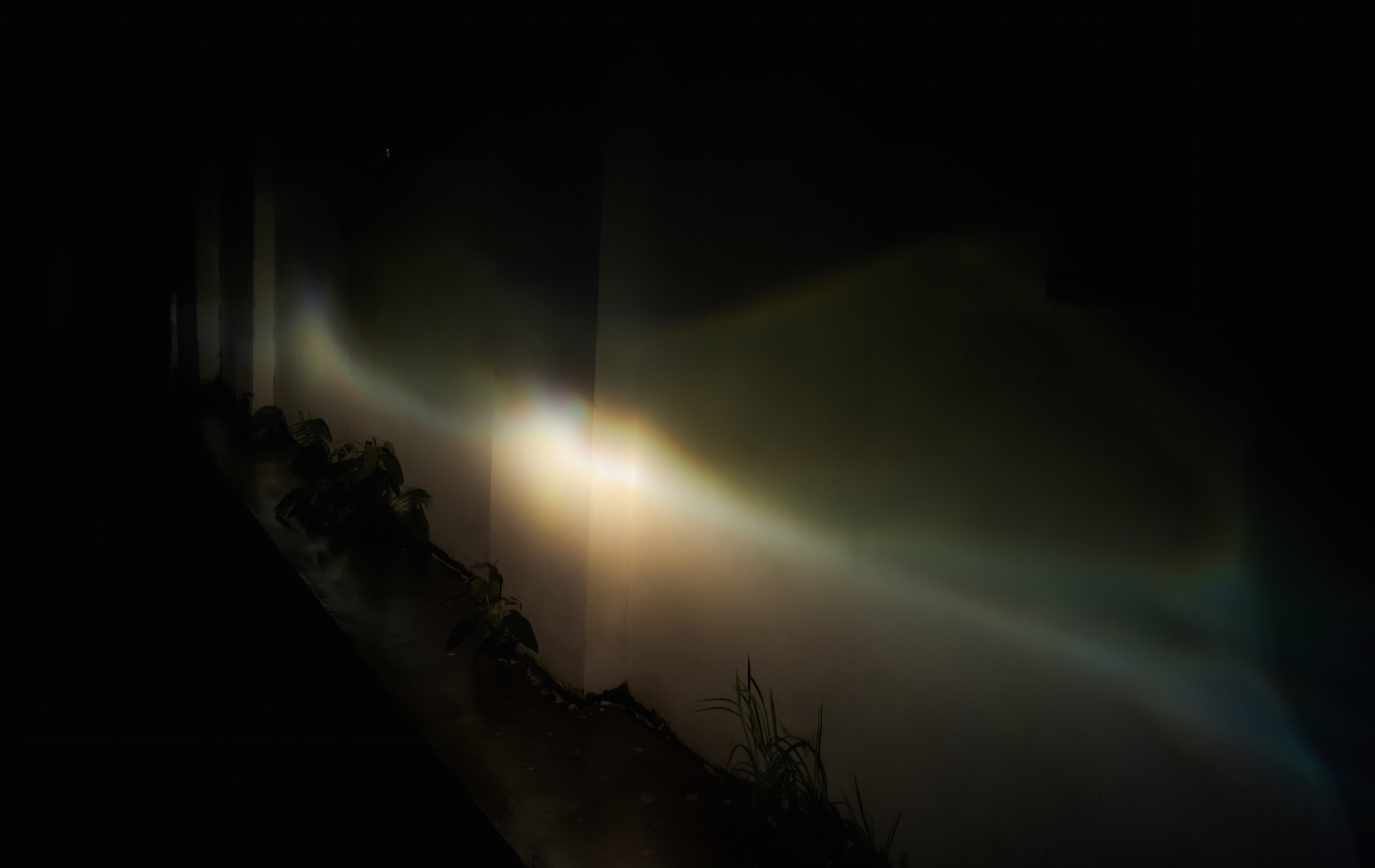
The photo was taken in a rainy night. By coincidence, I saw a car with opened headlights in a park. The light from the car was received by the white wall and the ‘rainbow’ scene appeared. The principle of this situation is due to the chromatic dispersion. The white light transferred in the air, went through the glass and water drops, and finally reached the white wall. In this process, light beams showed different colors had different index of refraction, and therefore refracted with different angles in the same medium.(λ in medium=λ/n, n1sin ø1=n2sin ø2) And because of their frequencies, the red light appeared at the top. In addition, the white wall is a perfect screen. I found that the rainbow was hard to created on other flats such as the on the ground. The reason is that only white wall can reflect all the colors of rainbow and the other flats with different colors will absorb part of the light in reflection. Besides, interference might also occur and caused the light to be constructive in this situation because the light travelled through two mediums with different index of refraction.
—— 6. Ang Li
It took this photo in my school at about 4:40 pm. The photo shows that the sky is turned red. It was really beautiful and the reason for this is that when the sun goes down the angle of incidence gets smaller that it is much easier to refringence. The refringence of the red light is lower than the other lights, as the result when the sunshine refringences through the atmosphere which full of moisture the other lights are reflexed and only the red light can be the further place. That is why the afterglow looks red.
—— 15. Dai Shi

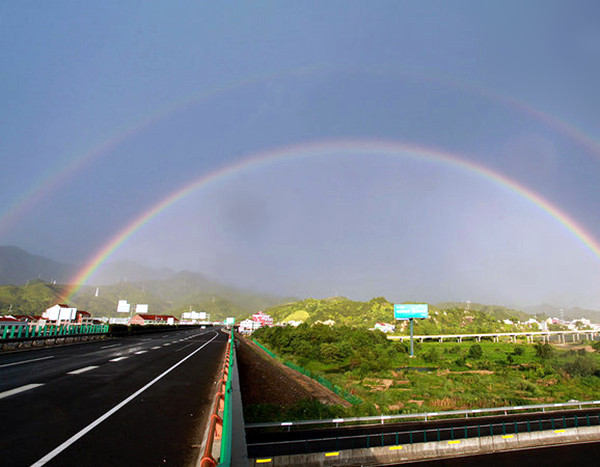
There're many optical phenomena in our daily life which can be interpreted by simple physics. This photograph from which we can see a “double-rainbow” was taken on the way to my nearby town. Formed by sunlight refracting and reflecting once in water-drops, the general rainbow has a color sequence from outer to inner showing as red to purple.(Because the refractive index of the red is the smallest and that of the purple is the biggest) It is called the “primary rainbow”. But as showed in the photo, the rainbow on the top is somehow weird as its sequence is averse to the one below and it's darker than an ordinary rainbow; this one is called the “secondary-rainbow”. The reason why its sequence differs from an ordinary rainbow is that the sunlight in some water-drops can have two internal reflections, making the color sequence somehow like a mirror image of the primary rainbows. Since light reflects twice in the secondary rainbow, it loses some energy; so that's why the secondary rainbow is darker and we can seldom capture sights on it. Physics is truly all around us.
—— 17. Yiye Dang
It was another rainy night. When the rain finally stopped, there were many raindrops remain on the glass window of my balcony, and the night outside the window is full of peace and beauty. Wishing to immerse myself into the beautiful scene, I sat down alone on the balcony, and turned all the light off, except one single small lamp, which was put in the corner of the balcony, surrounded by two perpendicular glass windows. And when all the other lights were off, it was dark both inside and outside the room, and the scene made up by the lamp and glass gave me a big surprise. Due to the reflection of light in the glass, there is one image of the lamp in each of the window. The images are so clear and vivid that they look like another two lamps hanging outside the window. Even more amazing is the third image, which occurs at another position, for which the four ‘lamps’ constitute the shape of a square. Though the reflection of light is a very common physics phenomenon which we see everywhere in our daily life, it’s hard for us to observe such clear and beautiful reflection scene. It’s a coincidence that the lamp was put at the right place and I turned off all the other lights that creates this unexpected beauty. Surrounded by almost total darkness, the four ‘lamps’ collectively look brighter than the single one, and at that moment, they are like the only light in the world.
—— 18. Yiwen Qiu
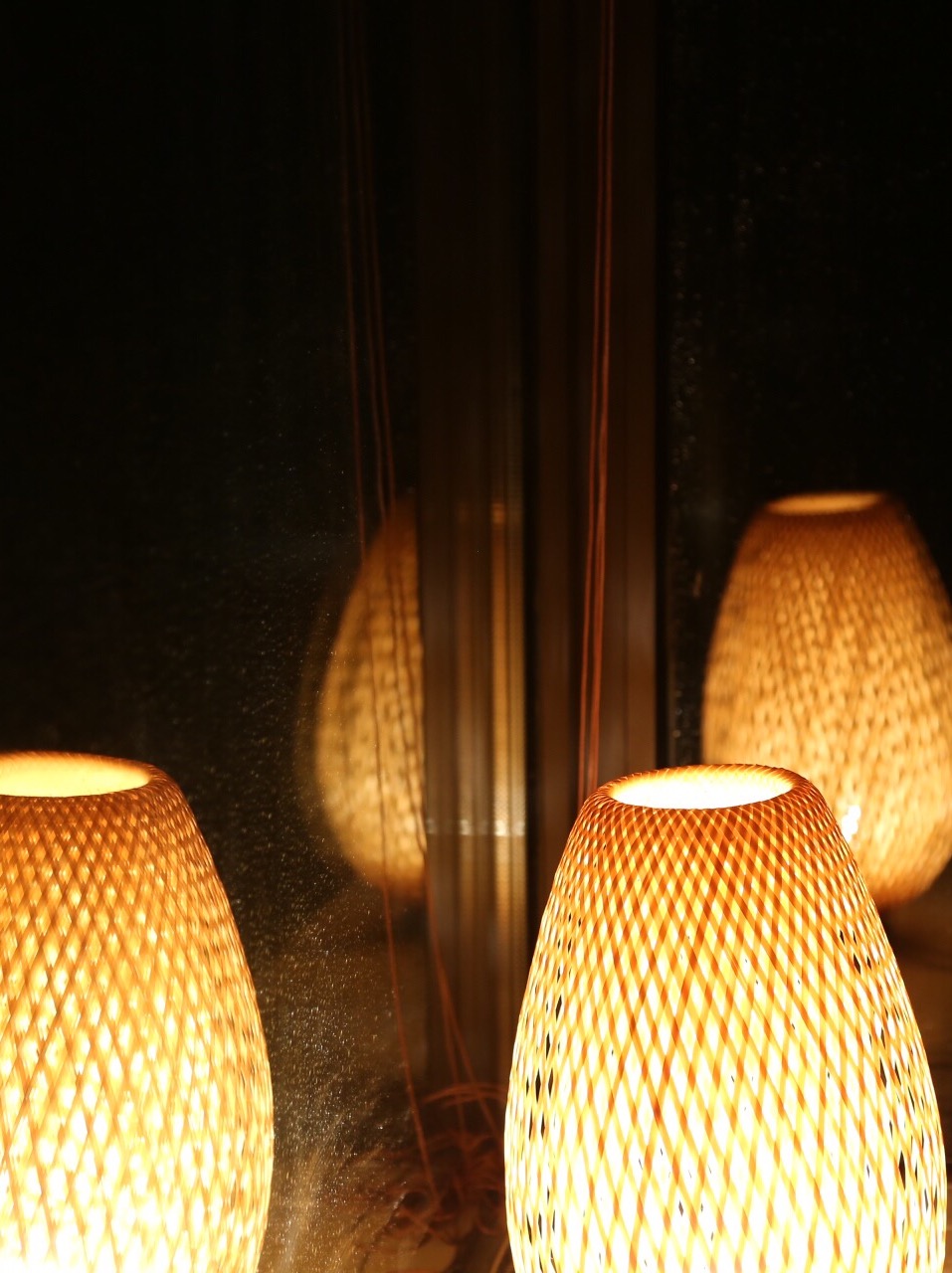
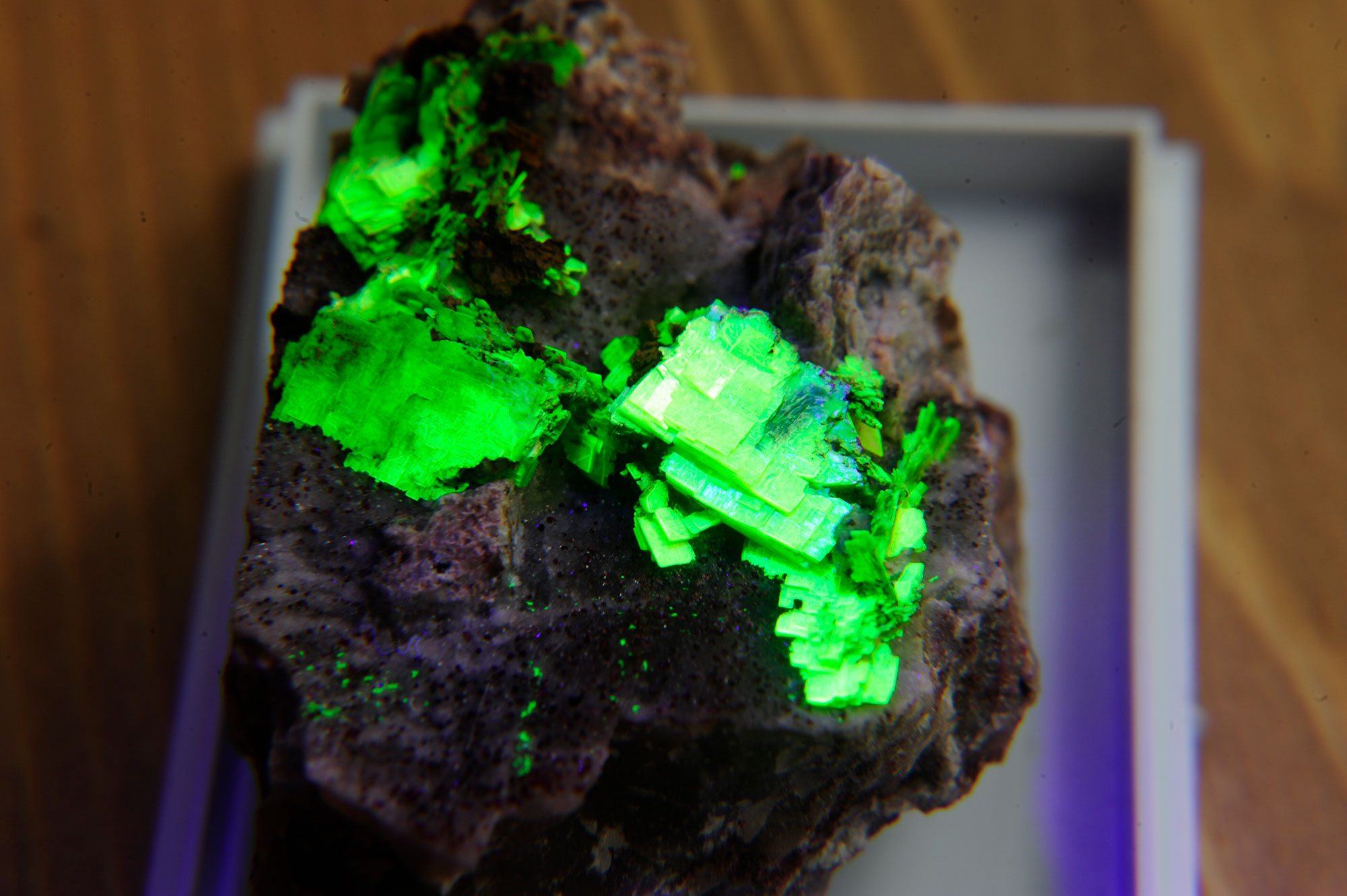
Radioactive minerals attract so many minerals collector of its beauty and mystery. This is an uranium mineral sample called Autunite. The mineral is light yellow in normal condition. This picture shows the mineral sample under the irradiation of ultraviolet light. The mineral showed a bright green fluorescence. The formation of the fluorescence is really amazing. When ultraviolet light irradiate in to the substance, the light was absorbed. Then the substance will be in activated state. Soon it will return to inactivated state, and irradiate light. The light that the mineral irradiates back is longer in wavelength than of the ultraviolet light. The fluorescence continues if incident light continues to irradiate. Don’t you think the fluorescence is gorgeous?
—— 25. Jiashu Wang
Physics hides in every corner in our live, waiting us to discover. Just like this image conveying, a simple plant settled in my home can demonstrate three phenomena of optics. They are magnification, optical distortion and chromatic aberration. The straight lines observed through the vase in the middle look larger than before. That is because the lines is located within the focus of the convex lens, which is made up by vase and water in it, so enlarged and virtual lines are produced. Also, there are several straight lines from background wallpaper have been bent due to the distortion. It happens due to the longer distance between light ray and principal axis, which means some light beams are collected on the border of lens, and higher scale factor of convex lens. The chromatic aberration takes place at the both ends of vase. It is related to the theory that white light, which contains light rays with different wavelength, will assemble in several locus when pass through thick convex lens. Therefore the colorful ovals the picture showing can be seen. The world of optics has truly admired me.
—— 26. Qiran Jia
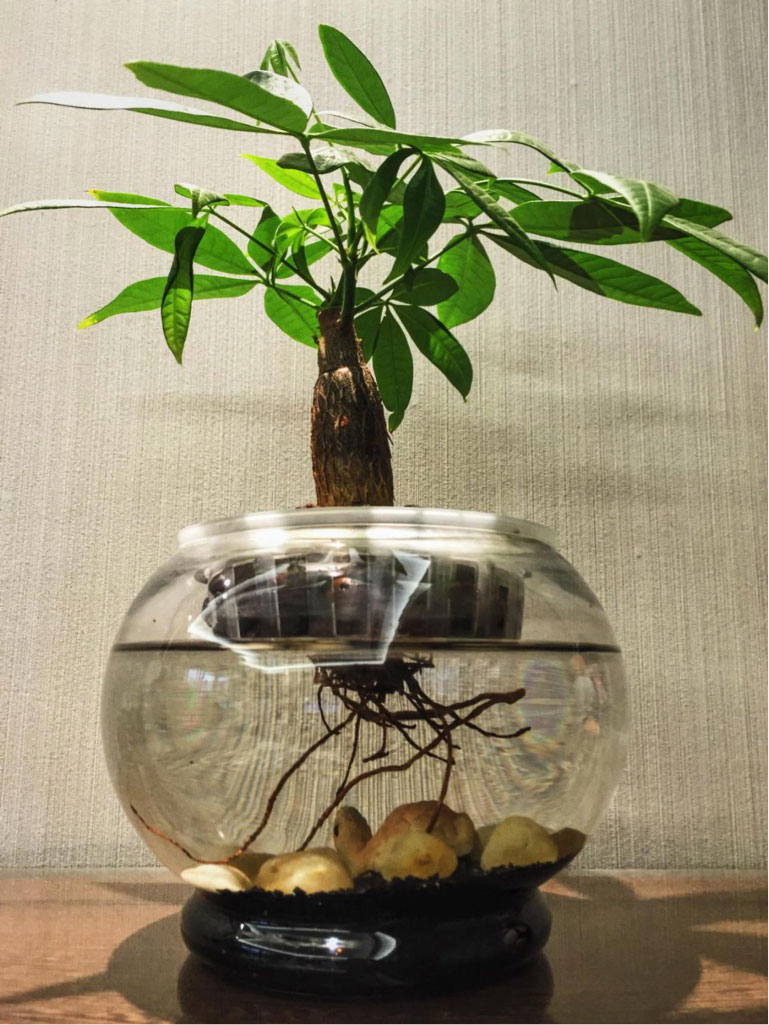
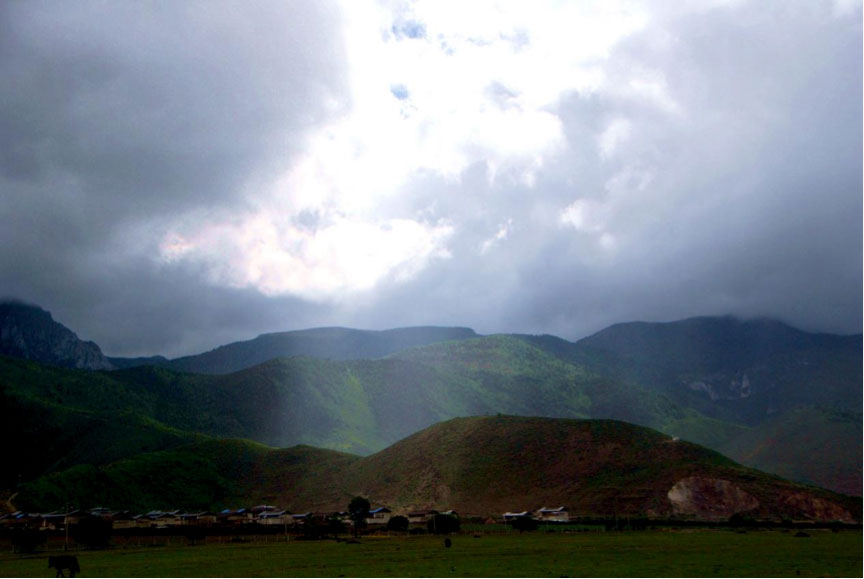
Taken in a prairie in Shangri-La, this photograph perfectly demonstrates the phenomenon of Tyndall effect which is characterised by the reflection of light as it comes in contact with small particles in a translucent medium. In this situation, dust and water droplets cause the light to be reflected in a scattered pattern towards the viewer, forming a 'haze'. Streaming through the gap between the dark cloud, the sunlight spilt over a small part of grassland as if it cannot wait to spread the sunshine to the vast prairie. With the guidance of the light, something womderful seemed to descend from the sky and release the depressive pressure caused by the dark clouds.
—— 32. Yige Zhu
This picture shows diffraction. The wind give water energy, so the wave product on the surface. However the waves of each side are different. Why? That because of the road resist energy to trave to another side. They pass though and spread out into the space beyond. It is this spreading out of waves as they travel through a gap. The gap width is approximately equal to the wavelength and the diffraction effect is greatest. So, we can see this phenomenon is clearly.
—— 33. Yiyang Wu
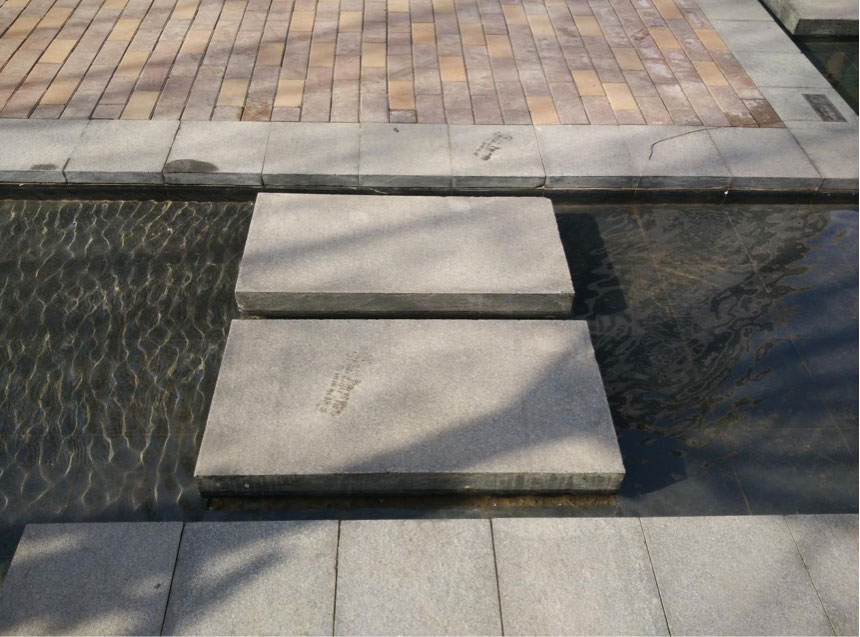
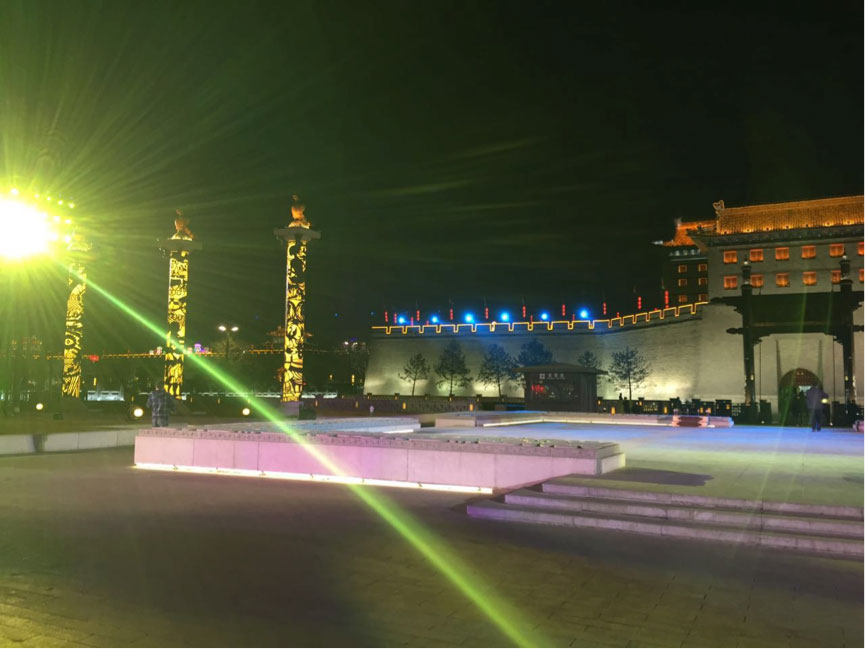
This photo is taken accidentally. when we take photos in dark, light source is always obstructive our photos. But in this photo, it contains many kinds of light in the dark: blue LED from the wall, red light from the building. but the most attractive light is the green light nearby. It’s very dazzling and you can see many beams of green light, but there is one beam of light reflect the most dazzling. This one is lighter than others. In my point of view, maybe because when taking this photo, the camera’s exposure function is still on, so the camera exposures this one light beam. Also, it exerts a virtual circle at the right side of the photo. This is called halation. It exerts when exposure a photo, the strong light cast on the photographic film and reflects on the cast of camera. Then the photo seems to have a halo.
—— 37. Zhongwei He
Title: Rainbow on the ground
If you are lucky, you can see an untouchable rainbow hanging in the sky after a shower. But now, in this photograph, we can see that the rainbow is on the ground while the irrigation sprinkler was working, pouring lots of tiny water drops. Because of the white light dispersion, it makes easier for us to close the rainbow. Dispersion brings us the iridescent rainbow from refracting and reflecting of the water drops.
Light waves have a particular frequency determining the light colors that we observe at last. In the rang of visible lights, the frequency of red light is the lowest one, and violet is the highest one. According to the different frequencies of monochromatic light, the various mediums will cause the various velocities of each light. Thereby, we get seven different colors of sunlight.
Now we can start to create our own rainbow now!
—— 40. Chuyi Zhang
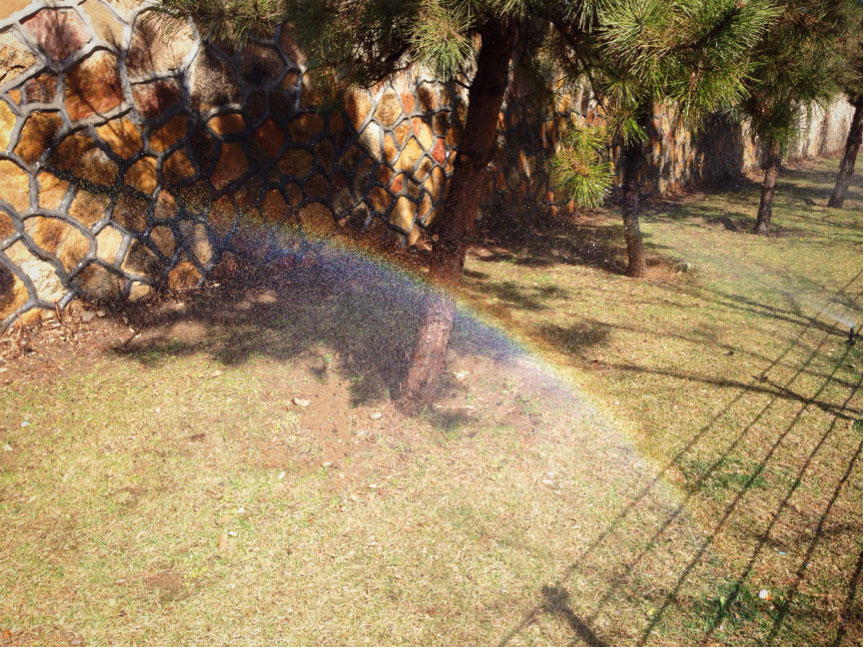
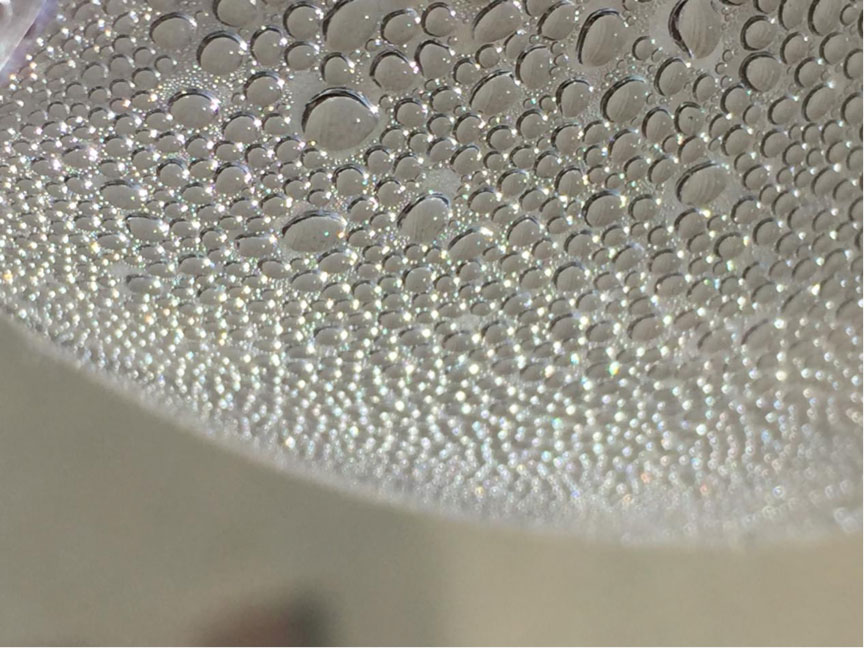
Shijiazhuang, the city where I took this photograph, is well known to the world for its heavy smog all year round due to the iron industries around the city. On an unusual sunny afternoon, I found this bottle of water that I brought this morning dotted with droplets. Those tiny little droplets evenly separated on this inner side of the bottle, reflecting the shadow of the sun. The physical reasons behind it was the effect of evaporation and liquefaction. As the sun appeared, sharing its heat to all over the world, the temperature of the water remained in the bottle raised dramatically; consequently, the water evaporated and became vapor, locking in the bottle and trying to reach the sun, but it couldn’t. The force of the bottle’s inner surface easily imprisoned those H2O molecules. There is nothing can make you feel more powerless than knowing that you will never reach the dream, although it was there, shining brightly above you. The water was still trying and didn’t give up. After, the vapor touched the inner surface of the bottle, which absorbed the heat of the vapor; the vapor liquefied, settling on the celling of the bottle. For the least, they got closer to the sun that they have never seen for so long. Like a pilgrim, those droplets purified themselves by put the image of the god deeply in their soul, displaying an abstract combination of two origins of life – water and the sun.
—— 41. Hanzheng Zhang
In this picture we can see the flame at the bottom of some fire balloons. When the fuel is ignited, temperature inside the balloon increases. Molecules inside the balloon move faster as the temperature rise, so part of the gas is exhausted. In this case, quality of gas inside the balloon is reduced. As the volume of balloon itself is constant, and the volume of the gas is the same as its container, the density of gas becomes smaller. The density of atmosphere is smaller at higher altitude. So the fire balloon rises up. As a result, the balloon rises to a place whose density is the same as it.
—— 42. Jiahe Tan


Solar halo, also known as circular rainbow, is an atmospheric optical phenomenon. It causes by the daylight which pass through the cirrostratus and been refracted or reflected by ice crystals. When the light rips into ice crystals in the cirrostratus and suffers two times of refraction, the light scatters to different directions. When there are the cirrostratus clouds in the sky, countless ice crystals float around the sun with a circle, which can refract a color of light to human eyes and form in solar halo. Also, there is often appearing one or even more halo that with the sun as the center. Sometimes there will be many points and arcs of light with colors or white. These halos, spots and arcs of light referred as halo. The physical phenomenon happened in solar halo are refraction, reflection and dispersion of light. Refraction or reflection is the change in direction of propagation of a wave due to a change in its transmission medium. In this phenomenon, ice crystals have different density with atmosphere. To explain the dispersion of light, prism is the best choice. In a dispersive prism, material dispersion, which is a wavelength-dependent refractive index, causes different colors to refract at different angles, splitting white light into a rainbow.
—— 44. Jialiang Wang
This is one picture that I took while I was on a field trip, and I found surprisingly that taking a picture through the lens could create pictures that were upside down. I realized that the shapes of the lens were spherical. The lens matched up with the convex lens model. Convex lens converge the light, in which case, an image can be formed. This picture was taken somewhere between the focal point and twice its focal distance. Therefore the picture was upside down. And the real flower must be more further away than twice the focal distance. Consequently, a real image which was upside down, and smaller than the original subject could be made. This interesting phenomenon offers a great example of how part of the cameras work, along with the theory that when objects are positioned somewhere twice farther than the focus, the image is smaller in size and “upside down”. Many people think that pictures taken through lens are originally like what we see, but actually that was a misunderstanding. Cameras turn the pictures again after the pictures are formed through the lens. No matter in which world, in the cameras or out there, the scenery is fabulous.
—— 46. Lingyuan lv

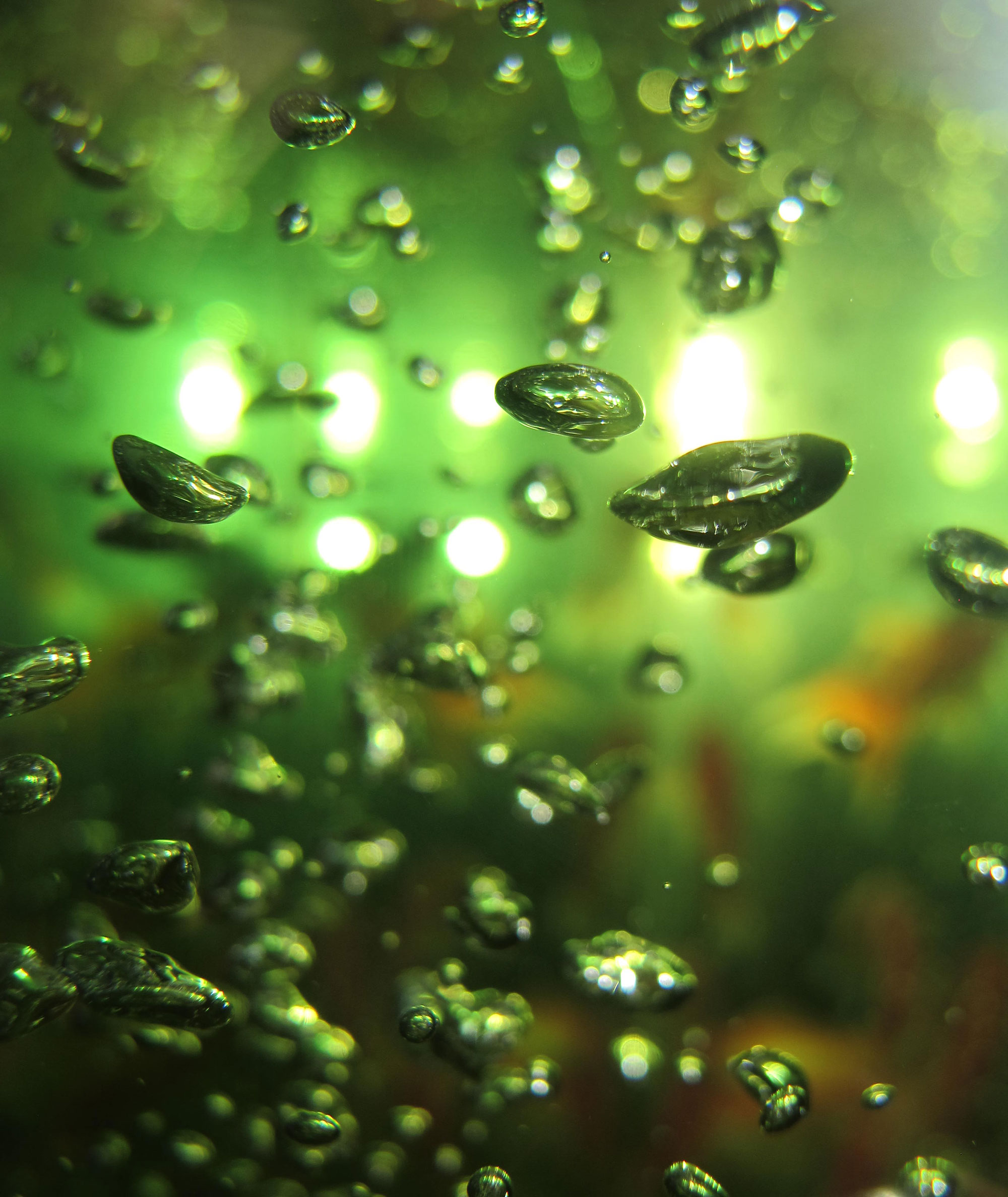
"I took this photo beside my grandma’s fishbowl, the oxygen pumping machine was pumping air into fishbowl in order to maintain fishes respiration .some water soluble gas molecules dissolved in water ,excess gas molecules will be free when the gas in water is saturated .and that water insoluble gas molecules are rise to surface due to pressure and density.
Gas molecules have smaller intermolecular force than liquid and more space between each molecules therefore it caused their mass per unit volume is smaller ,it create smaller density than liquid ,therefore the insoluble molecules moving toward surface .the oxygen pumping machine use cellular material to separate column of gas into gas drops,there is a intermolecular force contract with each other in order to maintain gas molecules not separate with each other and moving in high speed randomly.
—— 53. Yidan Ma
Honeysuckle is a beautiful flower with particular medical function in traditional Chinese medicine. In this picture, five blooms sink in hot water to make a Honeysuckle tea. As we can see, the three vertical blooms on the left and the horizontal one almost completely submerge in the water, with only tiny little portions of their tips coming out of the surface. This is because their densities are slightly lower than that of water, making their buoyancy of full-immersion, which are equivalent to the weight of water that would otherwise occupy their full volume, slightly greater than their gravity. Therefore, a net force emerged and pushed the flowers upward. And the unopened bud on the right levitates in the water. It is because at this particular instant, its density is exactly the same as the density of water. As a result, the attained buoyancy of full-immersion is the same as its gravity--no net force has emerged. The bud thus stayed static relative to the cup according to Newton’s first law.
—— 54. Yifei Zhang
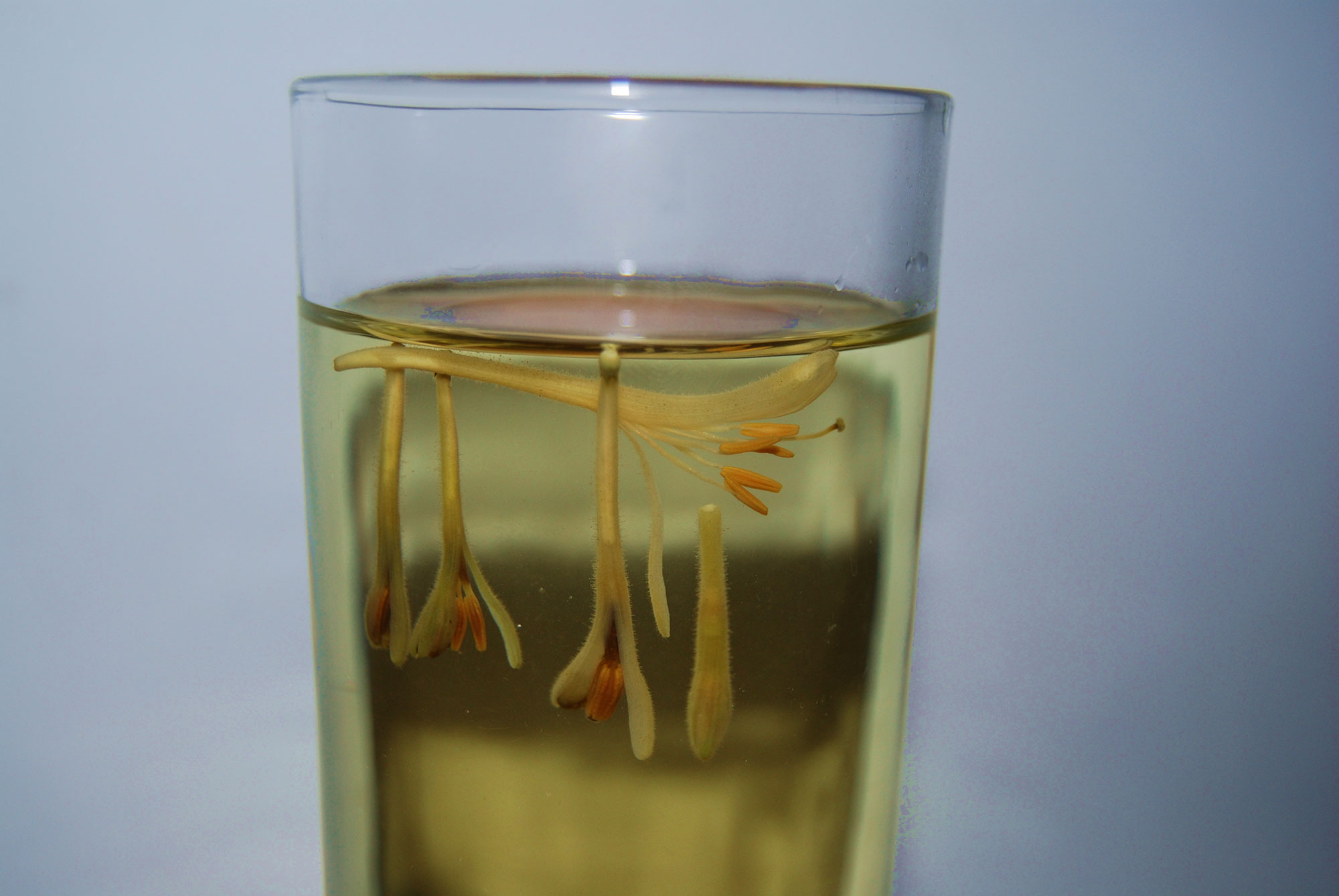
Contrived
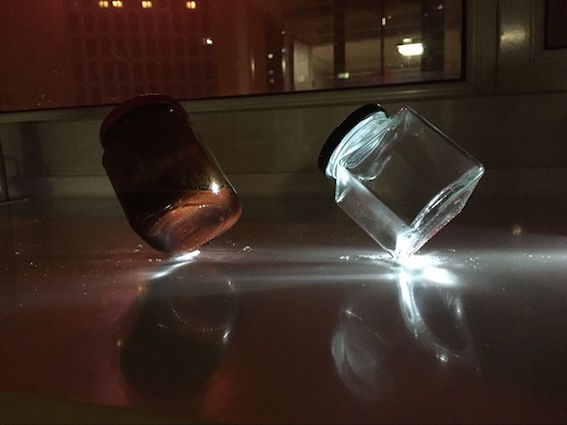
In my photo I balanced three square jars. I started by sprinkling a thick layer of salt on a table. Especially the place where square jar would be erected sideling by one of its bottom corners, I stacked salt as a little hill. The reason why I put salt is to increase the friction coefficient of the table so that the friction between the table and objects which are on the table would increase. I then put a square jar on it slowly and adjust the angle carefully. Trying to make the jar's center of gravity in the vertical direction project only onto the strong point where the jar's corner was on bearing surface. Finally when this jar was erected steady, I blew away all extra salt. But there would be a granule of salt supporting the square jar's bottom corner so that the jar could be erected sideling only by one corner.
—— 1. Lening Yin
It is known that laser beams are straight. However, in my photograph, a green laser beam is bouncing in the trough. To make laser beams bounce, I create a medium whose index of refraction can change with the height from bottom of the trough. Higher the medium is, smaller its index of refraction is. Such property let refraction, reflection and total internal reflection take place. I first put some syrup at the bottom of the trough and then same amount of water above the syrup. After leaving the trough for about 22 hours in static condition, bouncing laser beam can be observed when the laser machine is opened. I also put a strip of mirror at the bottom so that laser beam can bounce because of reflection. The laser beam can return to its original direction because of total internal reflection at the vertex. Light goes from optically denser medium to optically thinner medium, so it will be reflected to the original denser medium and show the shape of curve. Finally, the laser is able to bounce happily.
—— 2. Yingqi Ding
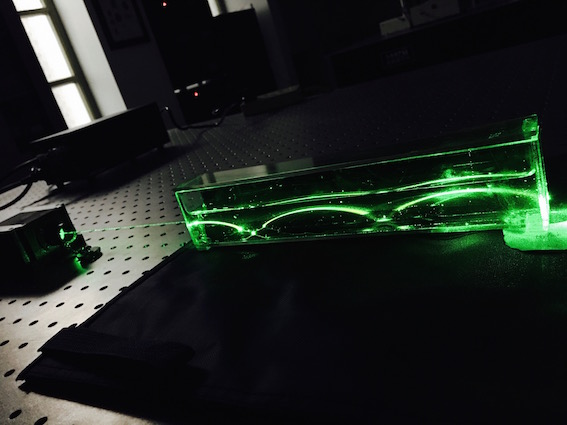
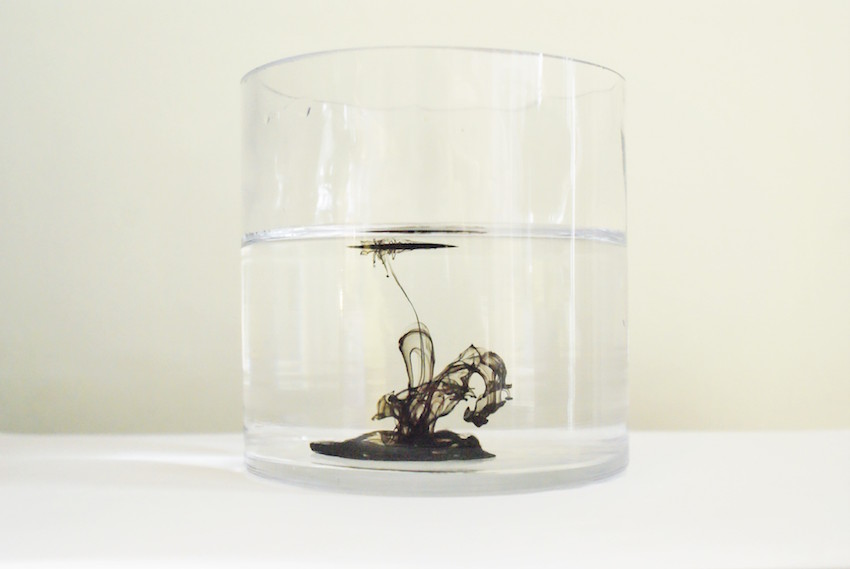
The photo was taken after I was practicing handwriting with a brush. As soon as I put the tip of the brush into a bottle of water to clean it, the ink began to fall down slowly to the bottom, which is a ‘magic’ and surprising process in the nature. This reminded me begin to think about physics. The particles of the ink are moving all the time so they separate with each other, flowing like a silk gently in the water. Meanwhile, the movement of water molecules collide with them, bouncing off in all directions, which means diffusion occurs. In fact, all the particles including water molecules collide unregularly, so that’s why we could see the pattern spread larger and silk-shaped. As a result, the ink would not only fill the whole bottle of water but also mix with each other after some minutes. From this phenomenon, we can also explain why after adding some salts into water, and the water tastes salty, though what we add in is a solid not a liquid, like ink. But, anyway, the theories are similar, owing to the movement of particles. I really appreciate the photo I took since it indicates us a physical phenomenon and what’s more important, it shows people all over the world about Chinese tradition--- handwriting using special brushes!
—— 5. Xinyi Zhu
This picture coalesces the wonderful performance of light and oil. For preparation, I fixed a blue paper, with three similar pentagons cut on it, on a torch. Thus, the light emitting from the torch is actually blue light with three prospective ''holes'' of white light. Then, I pour a little water in the glass container and some amount of oil on it. Oil is insoluble in water and has a lower density so oil can float on water. After stirring the mixture heavily, oil bubbles and oil film water of different thickness form. Using a micro lens camera, I captured a tiny part of oil bubbles and oil film, with the light projected underneath. Inverted image is shown since the curved surface of the oil bubbles acts as an optical lens. Also, when light passes through a different medium(oil, water and air) with different density, the speed of light alters, causing the bending of light and the curved image at the edge of bubbles. Macrophotography shows the micro side of an object: the round oil film looks like the holes on the moon, which makes this picture full of mystery.
—— 7. Yujie Liu
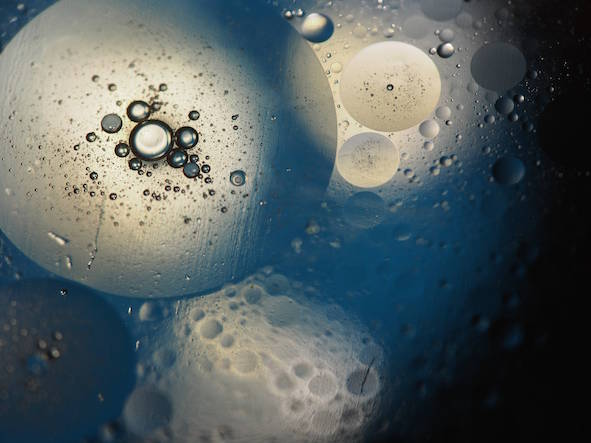
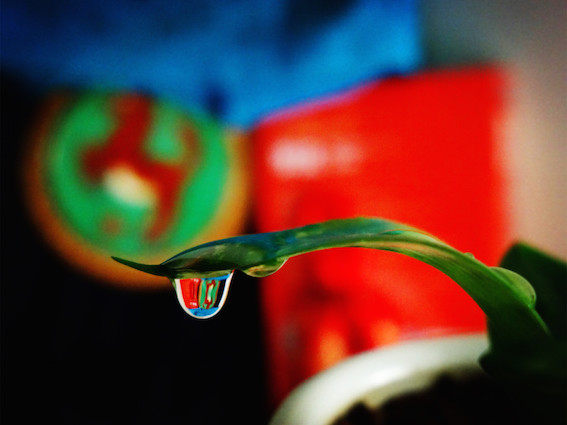
The principle of lens imaging drops, contains the nature of the scene to a small drop of water, and formed exquisitely carved images. I designed a set of red, green and blue three color background objects, after changing the background objects' positions, I found that the image formations through the droplet are being reversed from left side to right side, and they are also being turned opposite down, which is a really fascinating phenomenon to be observed.
—— 8. Junzhe Liu
This photograph shows a milk crown. At first, a drop of milk was placed on the smooth glass. After another drop fell on the same place, some milk bounced out and distributed around the milk drop. I snapped a shot of the third milk drop. Because of the acceleration of gravity, the gravity of the third drop turned into pressure and acted on the first two drops while the third drop contacted them. As a result of the Newton’s Third Law, the glass exerted a reaction force back on the drop. In this way, the milk bounced up on the external side. At last, the surface tension of the milk create the milk drop to form a “crown”.
—— 9. Yi Zhong
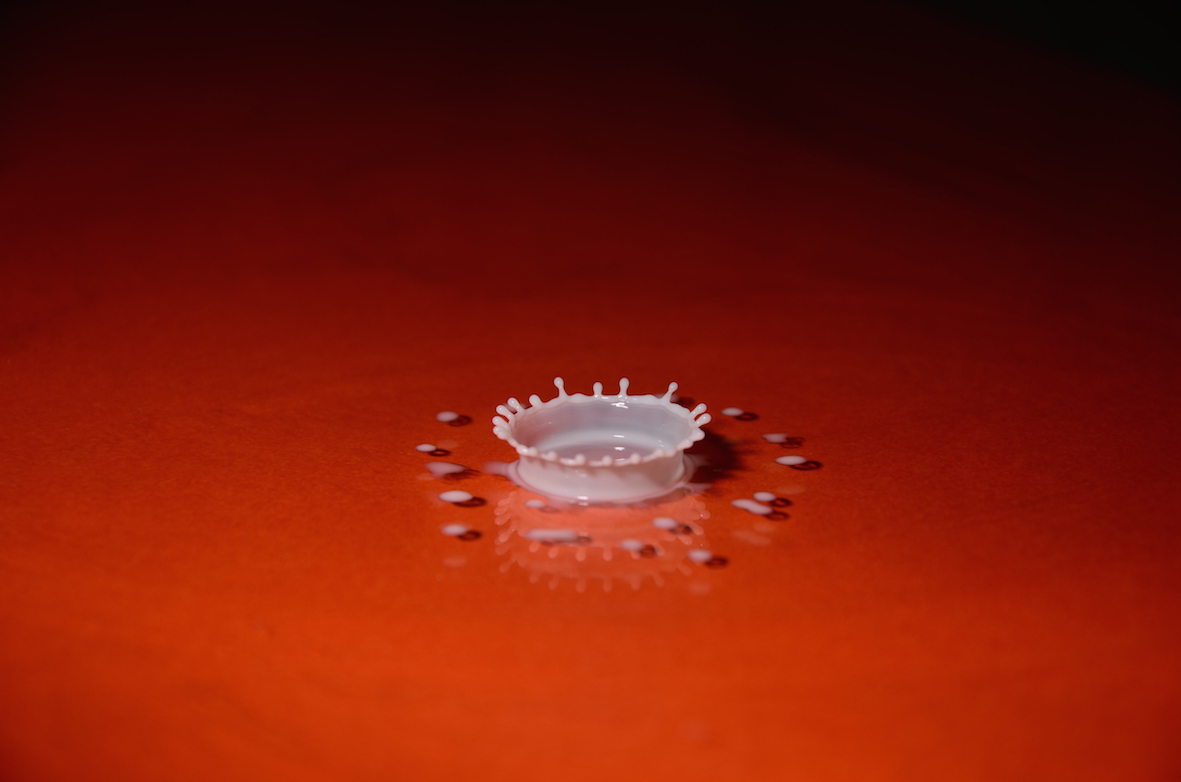
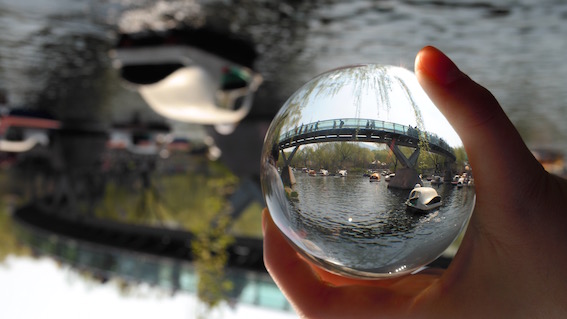
I took this photo in one of a park in my city. The crystal ball is a kind of convex lens that can serve for the convergence of light. It reduces image size and so includes a wide field of view, which is clearly represented in this photo. We can use the crystal ball to see the world in a totally different perspective. The world is put upside down by a single glass ball. According to the image-forming principle, when object distance is larger than twice the focal length, the converging lens produces a real and inverted image with reduced image size. Thus, the focal length, object distance, and image distance are all positive and the height of image is negative due to the inverted image relative to the object. From the thin lens equation 1/do(object distance)+1/di(image distance)=1/f(focal length) we know that if the object is at infinity, then 1/do=0, so di=f. Therefore, the focal length is the image distance for an object ai infinity.
—— 10. Manni Si
This photo is about phonology finished it use simple tools in the appropriate time and correct angle. The simple tools just is a have wave stripe glass with water, that why the light can shine like that photo show. For me, the correct time, is the afternoon with bright sunshine. And my house is facing south, so it is the best angle for my photo. If you enlarge this photo, you can see the edge of light appeared colorful color when the sunshine thought the water. That is the dispersion of light. The white light be divided into seven color by reflect and refract in the water. The most distinct color is red and yellow, maybe had orange. The most inconspicuous color is blue, had a little green. You also can seethe purple light; however you must be very careful to see the edge of the blue light. That not like rainbow in the sky clearly. Because different color has different index of refraction. The different light has different wavelength. So according to spectrum, you can see the red light is the most distinct in the topside. Actually, dispersion of light is a very complex. The exploration of depth will have more profound knowledge that we can learn. That is my simple and easy introduce. Thank you very much!
—— 11. Yuyi Liu
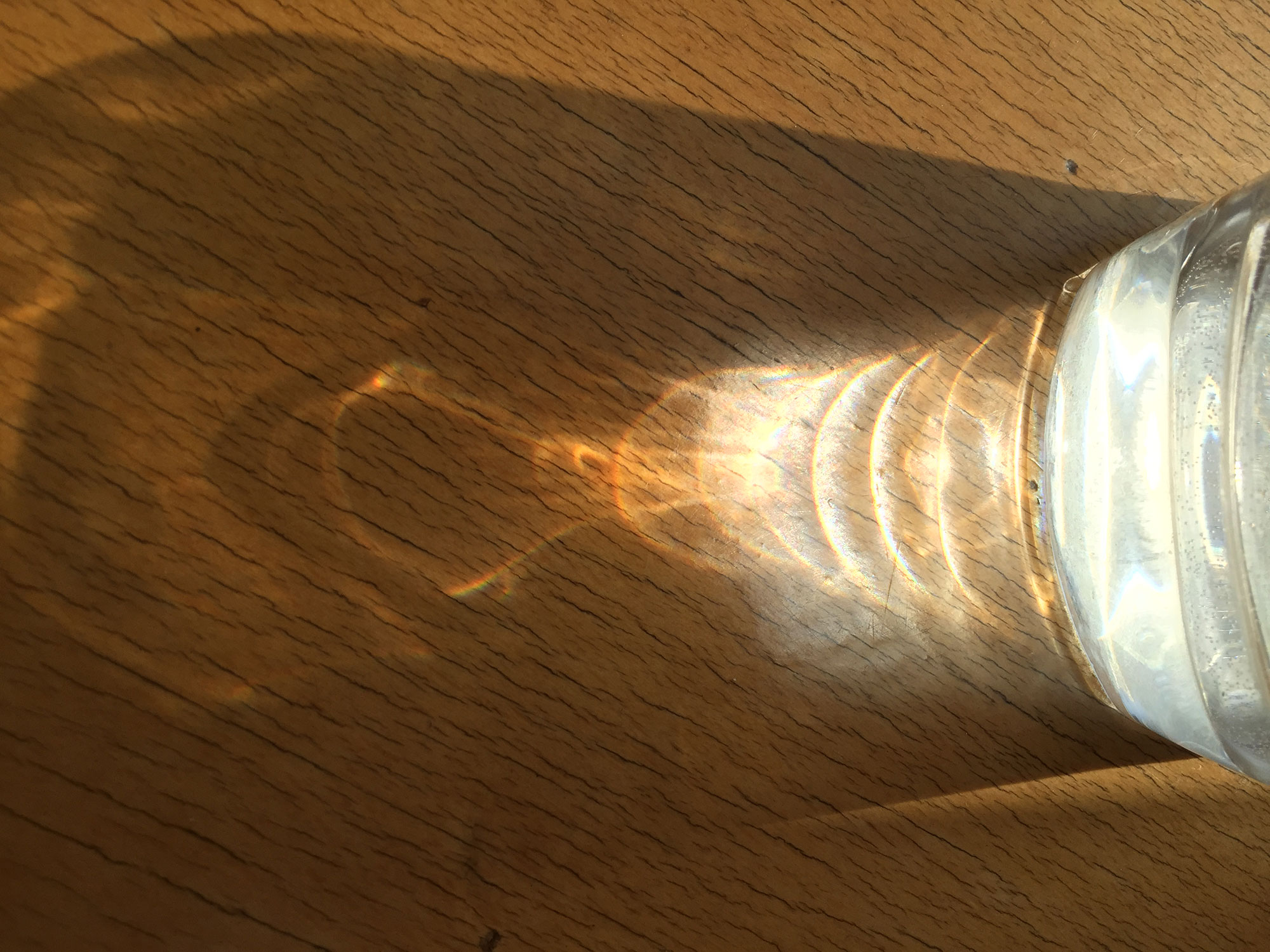
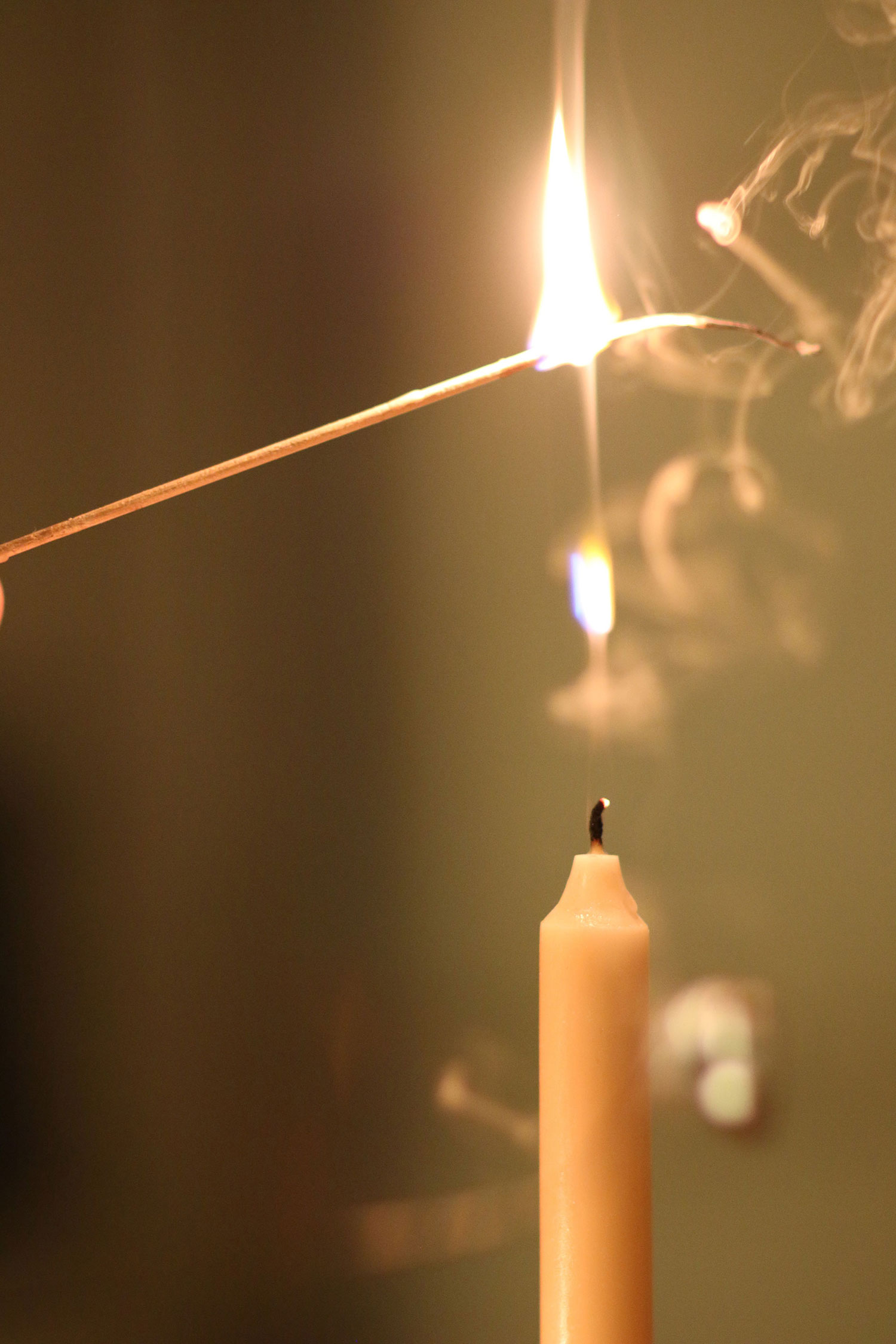
This image demonstrates how a candle was lit by lighting the smoke above the candle instead of lighting the candle wick directly. In the picture, you can see a burning stick, a blown out candle, a smoke line from the candle to the stick, and a spark traveling down the smoke line. In fact, the smoke line is made up of minuscule wax particles that were created when the solid wax became a gas during burning, allowing the heat to lift the gaseous wax above the candle where they met cooler air and turned into solid particles when the candle was blown out. You can view the smoke as tens of thousands of tiny candles that are absolutely burnable. Change of state and the properties of air movement are physics concepts that explain this phenomenon. Besides, it is a great idea to do this magical experiment at a friend’s birthday party!
—— 12. Yutong Zhang
This photo indicates the idea of how diffusion of water can be affected by oil. Followed by the principle of oil cannot mix with water, I decided to filled the glass with edible oil at first, and then dropped the mixture of liquid water and pigment with dropper. Consequently, It can be easily observed that the mixture of water and pigment formed circular spots contained different colors. This phenomenon created a sense of how water molecules bonded together but actually no chemical reaction took place. Oil has greater surface tension than water, therefore water molecules hardly diffuse when contact with water.
—— 13. Xiaochun Chi
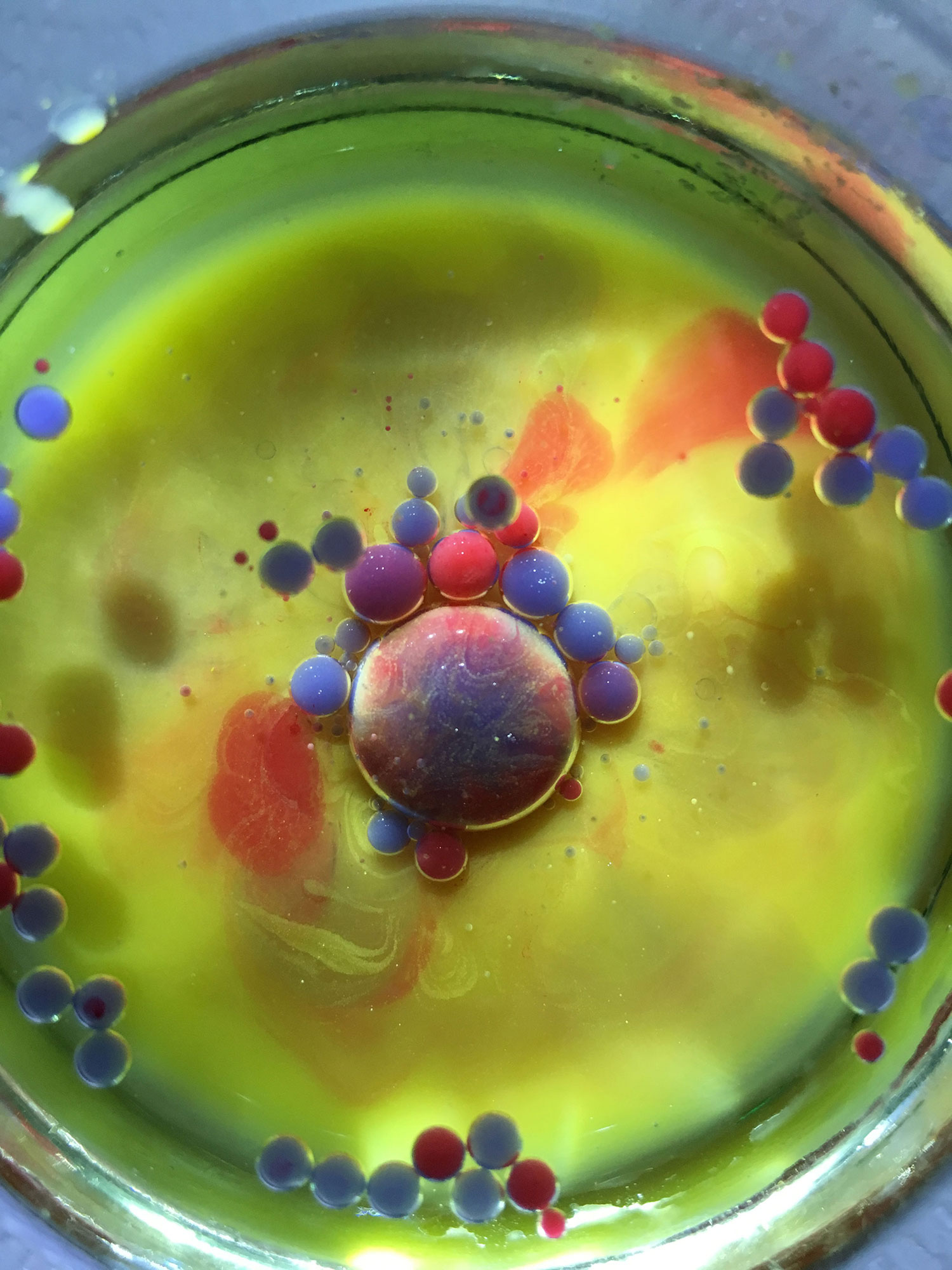
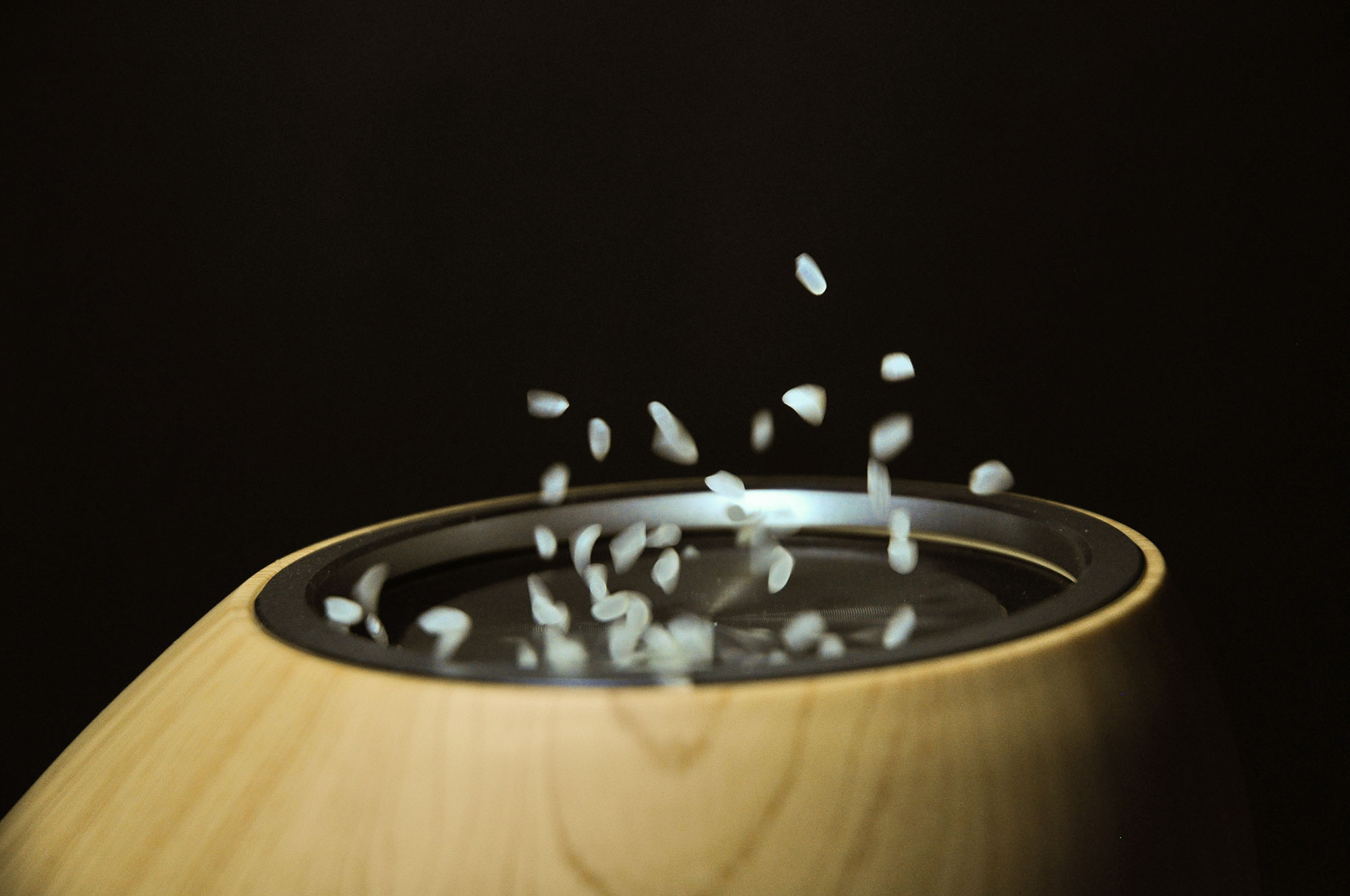
Energy can be transferred to many different forms. You can listen to the music by speaker because it transfer electric energy into wave energy. The kinetic energy of speaker vibrates the air and it will be detected as a wave energy, the sound. People can’t see this conversion of energy in naked eyes. Yet, placing the particle on Diaphragms can help us to detect the vibrating. I placed some grains of rice (particles) on diaphragm of my wood speaker. When I played the music, I could see that particles were popping around. This phenomenon is caused by kinetic energy from speaker. The kinetic energy not only vibrated the air but also changed the mechanical energy of the particles.
I took about 200 pictures of the movement of particles and chose one of the best shot.
—— 16. CHO SU AH
The process of solidification is demonstrated in this picture of wax oil and water. In order to capture the photograph, I pour out the wax oil into the wine glass and take the photo at the moment when the wax oil is solidifying in the water (before the solidified wax oil float to the surface of the water). During the time the hot wax oil is being poured into the cold water, the large difference of temperature between the oil and water causes the wax oil to rapidly release heat to the water and thus quickly becomes solid or semi-solid state. When the wax oil is poured, the high flow rate of the oil makes it rush into the center of the water and form solid wax before floating back to the surface; due to uneven resistance force exerted on different parts of the wax oil by water, the shape of the wax is pretty random after solidification, which brings up the beautiful patterns inside wine glass of the image.
—— 19. Ruohan Wang
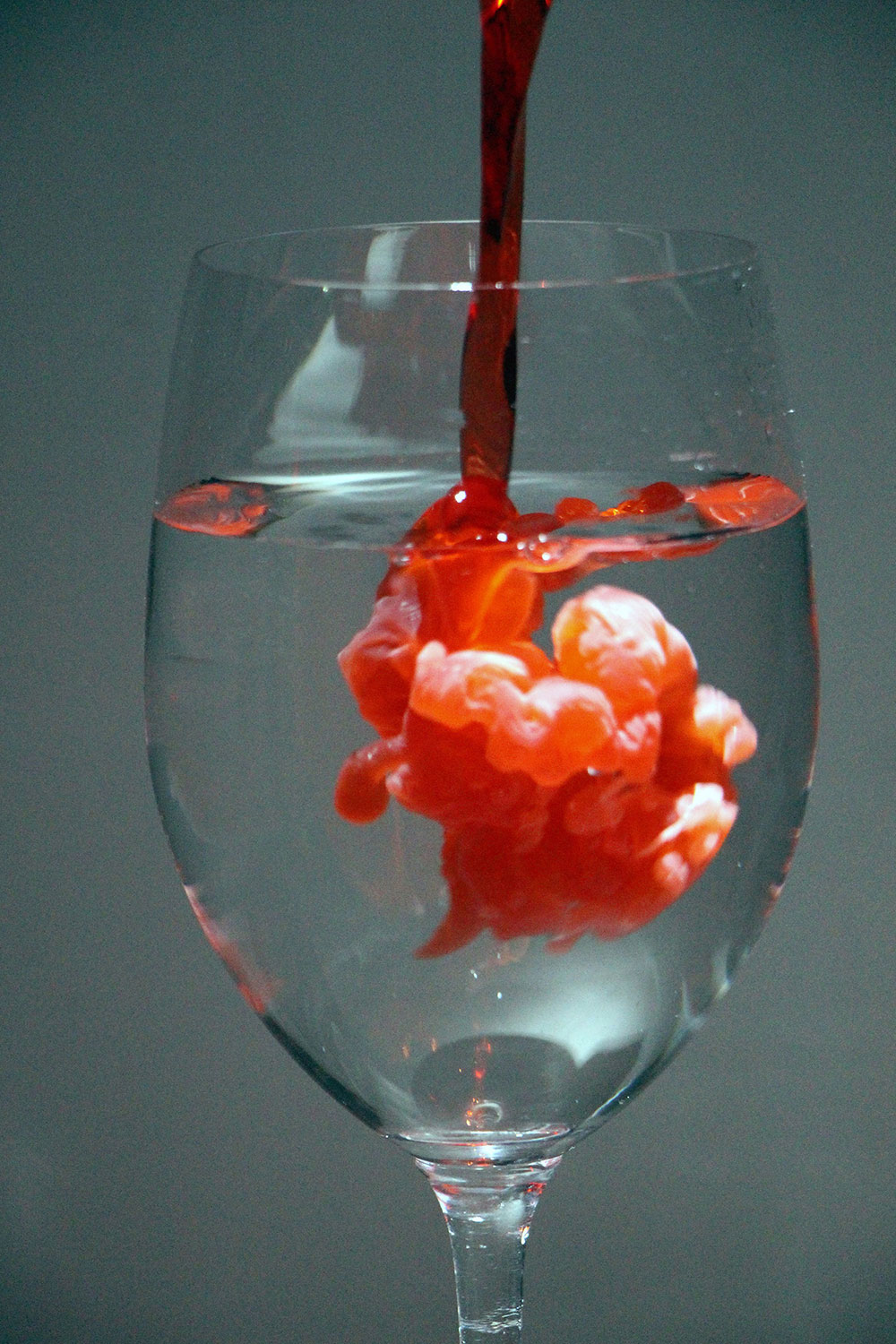
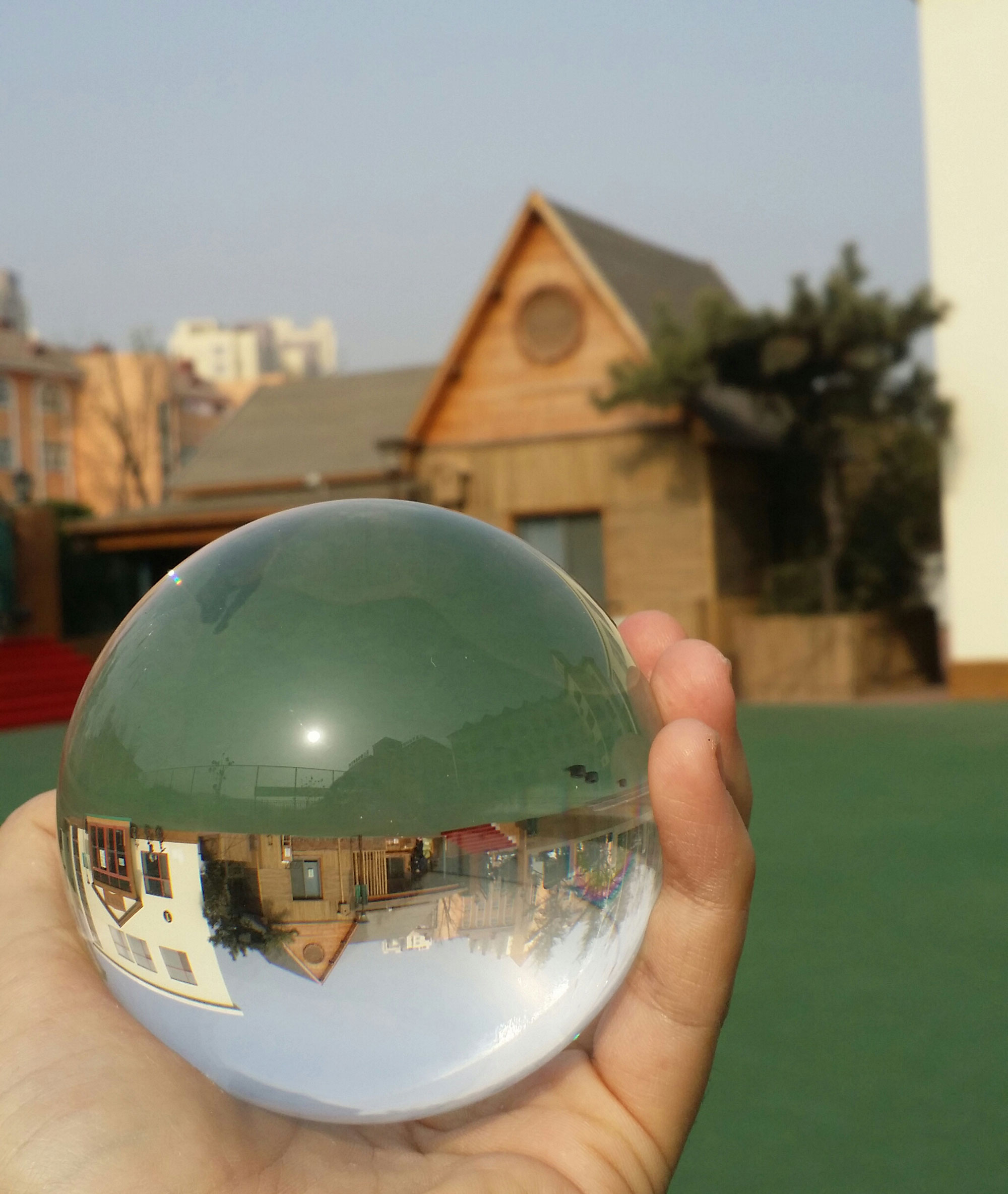
Miniatures of big structures are in the glass bead so let people seem that the world is in my small hands. Interestingly, the world in the glass bead seems to be upside down. It is because of refraction of light. Refraction could be described by Snell’s law, Snell–Descartes law and the law of refraction, which an equation used to be explained by the relationship between the angles of incidence and refraction, when referring to light or other waves passing through a boundary between two different isotropic media, such as water, glass, or air. Actually, they have two kinds of lens: convex lens and concave lens.
First, concave lens makes light be scattered and light rays refract outwards, but the other is different. Second, Convex lens can be used for magnifying lens because they make parallel rays focus in on a focal point. Convex lens can usually be used for magnifying glass, so people who have farsightedness with an old age can use this lens to read something.
The glass bead is one of the convex lenses which can refract the light to make some structures seem reversely. Then, if you put glass beam, convex lens, far away from your eyes and see something far away from you, you can see some structure reversed. It looks very interesting and makes people have fun.
—— 20. CHO HOONHEE
This picture demonstrates the idea of Surface tension.
Surface tension is an effect where the surface of a liquid is strong. The surface can hold up a weight, and the surface of a water droplet holds the droplet together, in a ball shape. The stone can float on a surface because of surface tension, even though they normally could not float. Some insects, water striders can run on the surface of water because of this. This property is caused by the molecules in the liquid being attracted to each other (cohesion), and is responsible for many of the behaviors of liquids. In order to do ducks and drakes well, you need to use pebbles with large and flat surface to maximize the surface tension.
—— 21. BAE SOO BIN
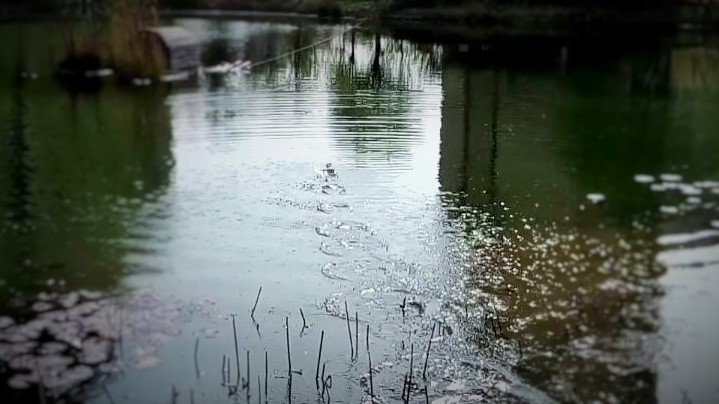
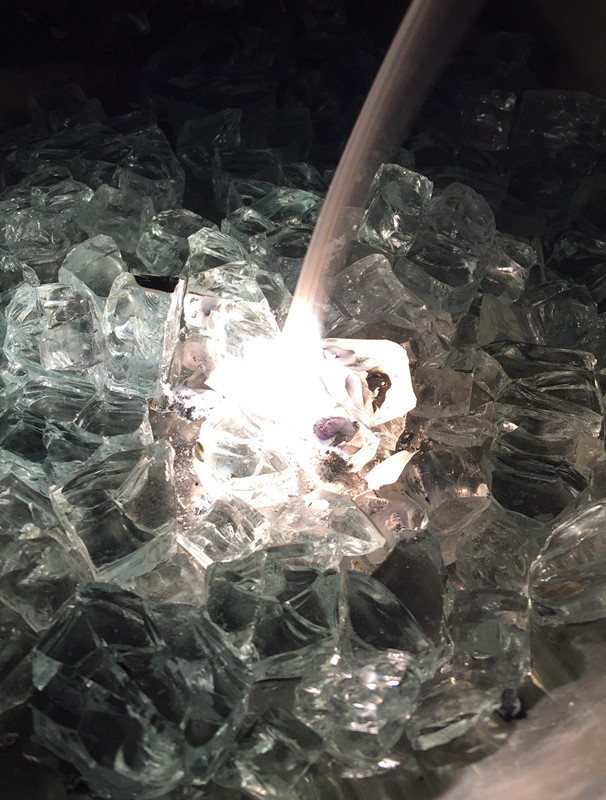
Flame color depends on several factors, the most important typically being black -body radiation and spectral band emission, with both spectral line emission and spectral line absorption playing smaller roles. A spectral line is a dark or bright line in an otherwise uniform and continuous spectrum, resulting from emission or absorption of light in a narrow frequency range compared with the nearby frequencies. Certain element emits certain wavelength of light. This picture is showing the white light ray during the combustion of certain magnesium through the glass pieces. And this glass pieces are reflecting and refracting these lights spectrum. Emitted light spectrum is refracted by various irregular shape of glass fregnants so it finally show the beautiful phenomenon.
—— 23. KWON JINYOON
This picture is shows the concept of ‘ Real World Fantasy’ .It was took on a cloudy day, and the city was have heavy flog. I noticed that there was a decorate crystal on my table, so I through it to look out of outside, and was surprised by the beautiful image it appeared. It is caused by refraction When a ray of light wave is refracted, the path it follows bends at a particular point, and it enters the glass so that we could see bending of the light rays on the image with different colors. Therefore It shows different views and angles put together side-by-side hence the picture just became more colorful without artificial adjust. In spite of the city was serious polluted, but we still could see that in an optimism way, which is determined by the view of how people see the world. I love this picture because it is so interesting and also can make people to rethink to be more environmentally by changing our behaviour like reduce pollution make the sky return to blue! All contribute by RERRACTION!
—— 24. ZIxuan Chen
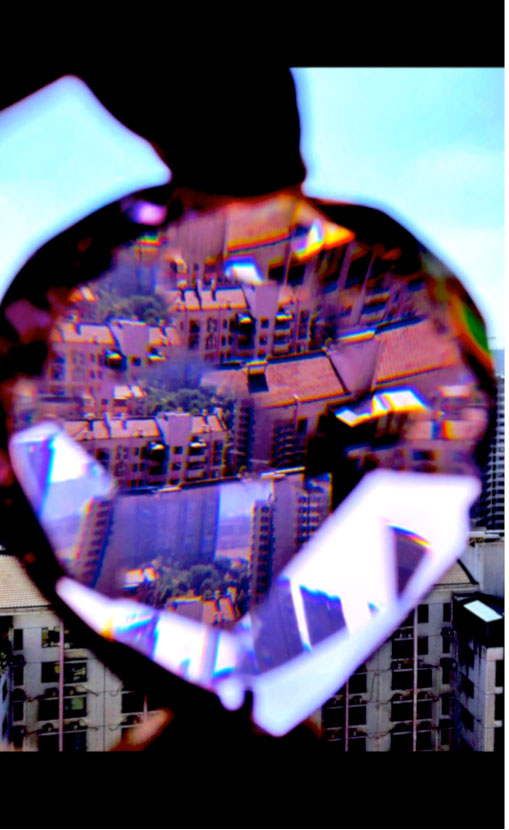
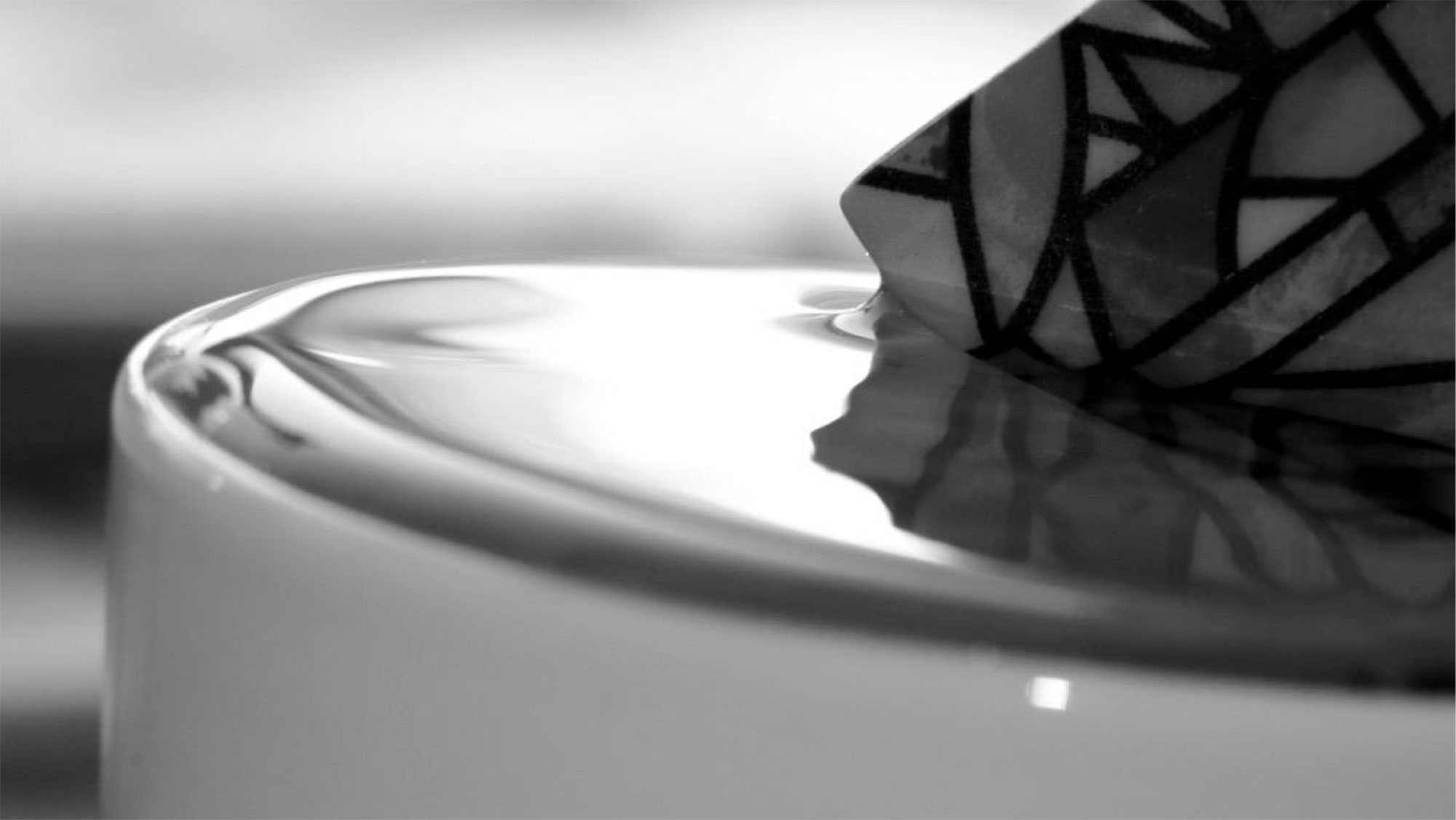
“Why did the edge of the water ‘climb up’ to a higher level, compared to other portion of the water plane, but not sprawl out?” The question hit me when I put a Gowdy-designed glassware into a narrow-top cup that was filled with water one day. After capturing this moment, I did some searching and found out the answer was surface tension. At the interface of liquid-air, since the liquid molecules have greater attraction (due to cohesion) to each other than the air molecules (due to adhesion), the net force’s direction is inward at its surface. The imbalanced force causes the liquid to behave like its surface is covered by a layer of stretched elastic membrane and the surface is under tension. When the glassware was placed on the water and depressing the surface, it was balanced by the surface tension forces, which were parallel to the water’s surface at the points where it contacted the glassware. Surface tension of the water had the tendency to keep the water surface complete, and thus the edge of the water seemed “climb up”.
—— 27. Xue'er Fei
This is a goblet of water and a model of the Eiffel Tower. The Eiffel Tower reflect light into the goblet and then into the camera. Here, as a goblet of convex lens position. At the top of the Eiffel Tower really bigger than the lens to like, because like outside twice the focal length of lens, like a handstand miniature inverted image.
—— 28. Xueqing Hu
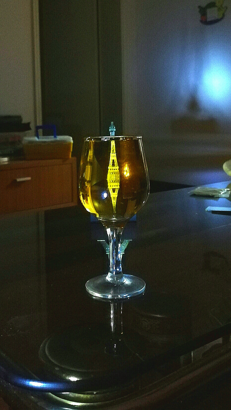
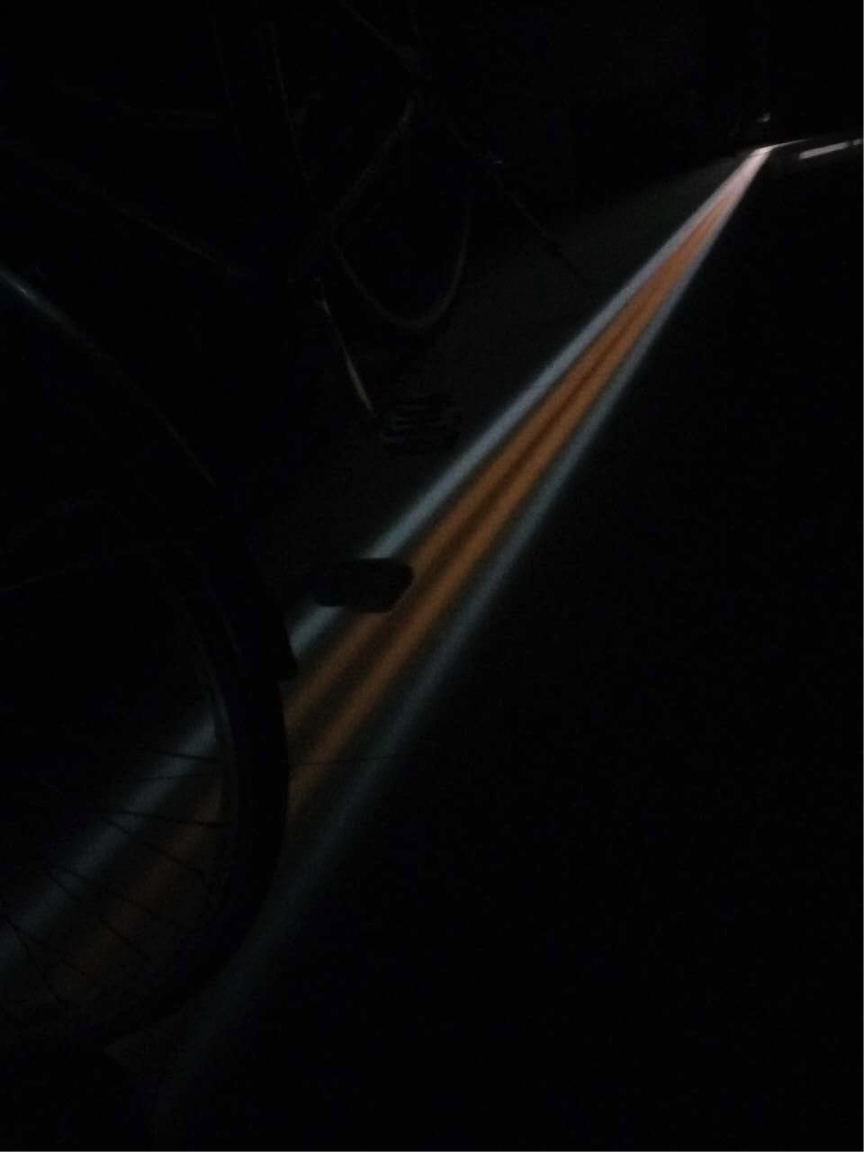
Light before the door is white light originally, and after the white light enters the small gap that made by the door, a physical phenomenon occurs, diffraction of light.
This is because light wave will change the shape when it passes the small gap and it will be strongest and the most noticeable when the size of gap is similar to the wavelength of light.
In the picture, the white light is divided into several different colors, which indicates the fact the size of the gap is almost coincided with the wavelength of the waves .In addition, the phenomenon is also demonstrated that the white light consists of different kinds of colored light.
—— 29. Xuning Ma
This picture shows the irregular movements of molecules in both hot water (left) and cold water (right). It can also be observed that molecules would move faster in hot water than in cold water. To take this photo, I firstly prepared two caps of water with equal volume but different temperatures. Then, my two mates took the black ink and dropped it into two glasses at same time. In hot water, the ink quickly separated and covered a huge space. Comparatively, the ink in cold water just kept a line and dispersed more slowly. Every kind of molecules could move erratically and then spread. Higher temperatures will help them move faster. That is called diffusion and could be used to explain many phenomenons in life, such as how smell spreads and is received by creatures, why we can make salty water with salt, and how people’s lungs exchange air.
—— 30. Yi Li
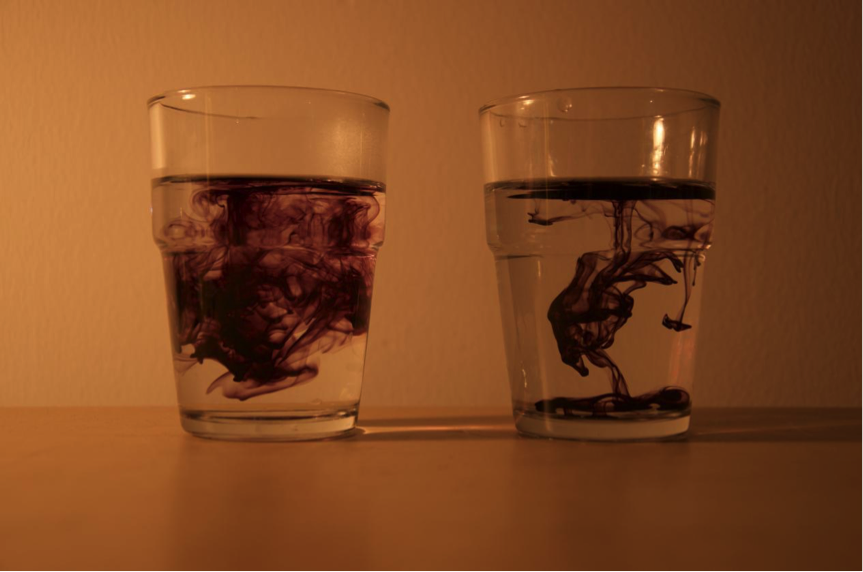
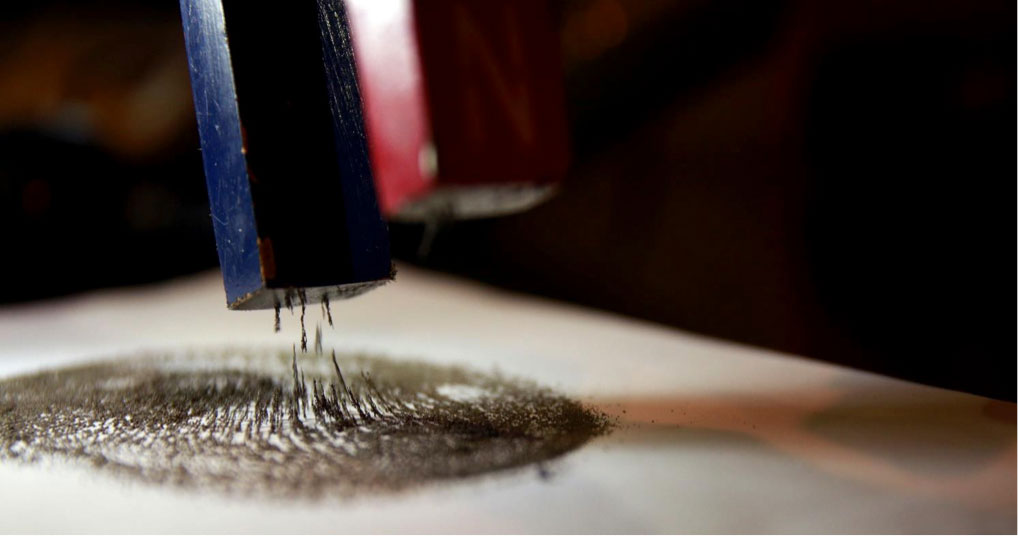
This photo was taken in the instant that I put the magnet close to a layer of iron powder. Usually iron powder is shapeless and sand-like, like the ones on the edge of the powder in the picture. However, when I gradually move the magnet toward the powder, the little particles will suddenly accumulate together and form numerous and concentrated, sharp and short lines along the magnetic field lines and stick to the magnet quickly. This photo clearly shows the two distinguished form of iron powder and the process of the movement of the powders.
—— 31. Yi Xie
This picture depicts two interesting phenomena of pressure. I put a balloon on a board with nails. And I put some heavy books on the balloon. If we press a balloon on a nail, we know that the Balloon will pop, but in this picture ,a balloon was pressed on plenty of nails and didn't pop. That is because, when the force is constant, we use more nails so the contact area between the balloon and nails will increase. And then, the pressure will decrease so the balloon won't be punctured so easily. As for the fixation of two balloons which are above the books, I put a little suction cup and a balloon together, then I took out of the air in the cup. So the pressure in the cup was smaller than that in the balloon and the balloon would appear as convex in the cup, then they connected together.
—— 34. Yueqian Zhang
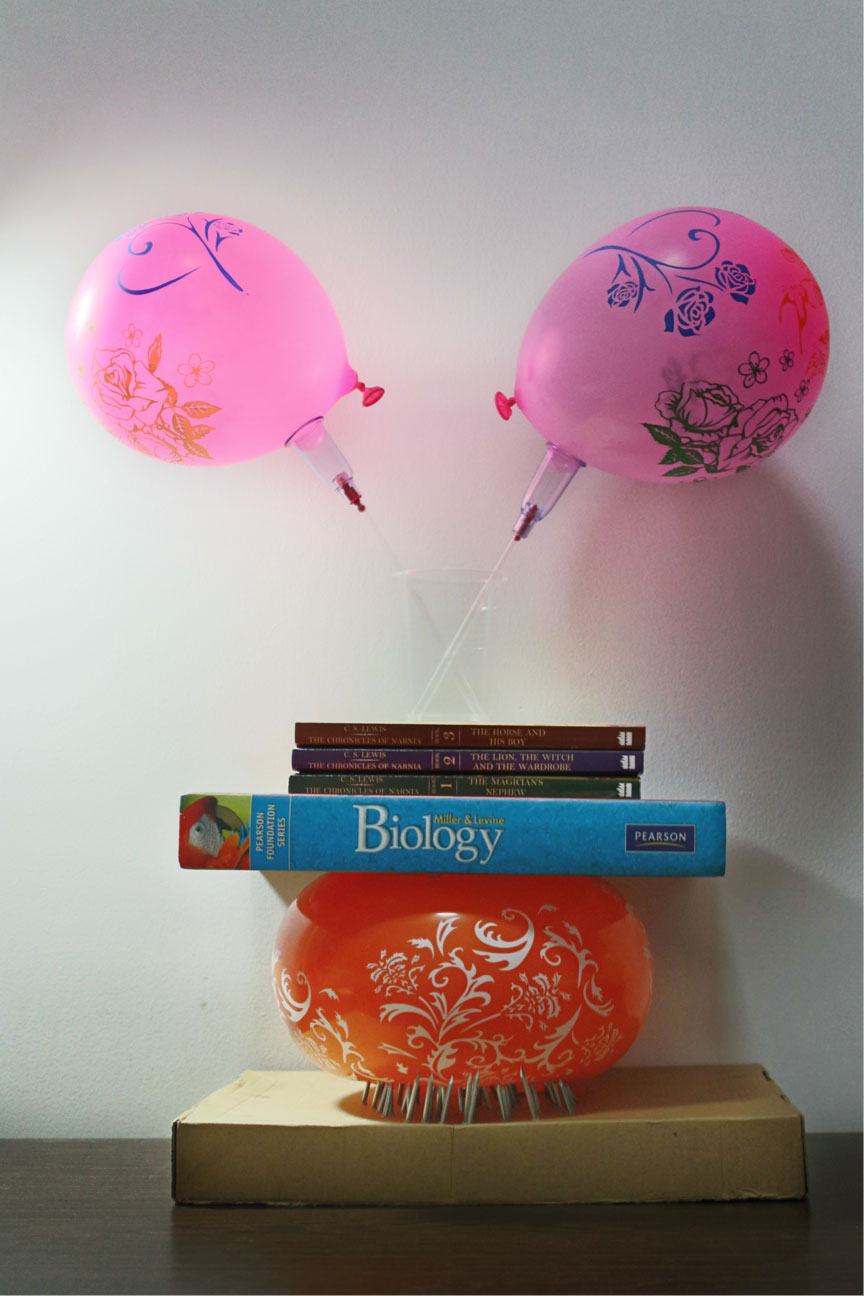
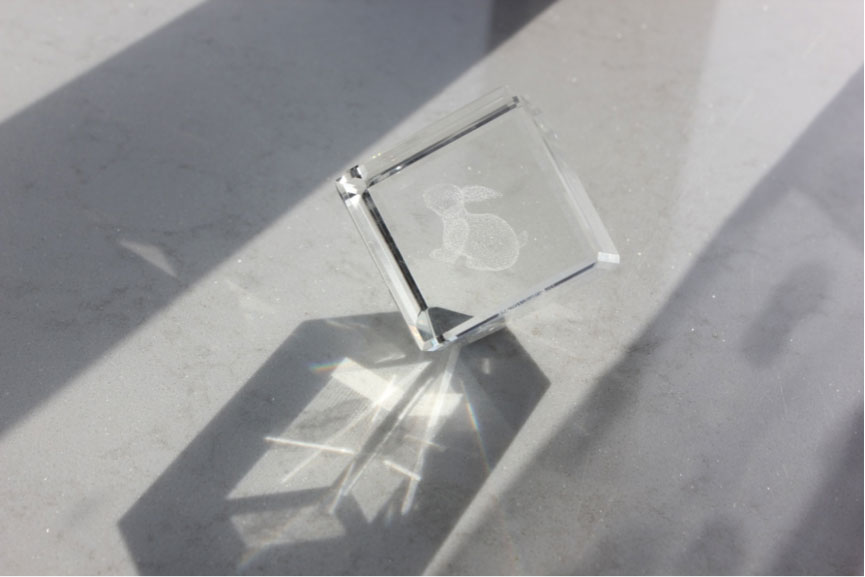
Optical light reflection, refraction are demonstrated in this photograph. To take this picture, I put a irregular block which with a triangle shaped space on the bottom, on the Marble surface. The surface displays some sun light rays which traveling passed through a different medium—Glass. The rainbow displayed too, and is caused by dispersion. The light rays are refracted twice, once as they entre the prism, and again in the same direction as they leave it. The dispersion increase then the colours are separated so much. The glass within the base ,so is stable and triangle shaped space is separated to vary large pressure.
—— 35. Yuyue Zhang
This picture displays at least three physical phenomena.
First, this bubble is made of water and takes a spherical shape , because of surface tension. Surface tension is a phenomenon that water molecules at the surface are looser than others. Therefore , the surface has stronger forces and are pulled inwards . This internal force contracts the surface to the minimal area and the imbalanced forces of the surface level resulted in the bubble’s spherical shape. Interestingly , only with detergent in water , the spherical bubble can sustain since its surface tension will decrease to ⅓ of the original leading to the stability of the bubble.
Second , the bubble is colorful . When polychromatic light (sun light) irradiates on the bubble , reflection and refraction will occur . When the rays travel to the outside and inside surfaces , they will be enhance or offset , and refraction will cause the chromatic dispersion.
Third , we can see two images on the bubble . The upright one is virtual image . But the upside down image is real image . Because the bubble takes a spherical shape , it serves as a convex lens , which converge the light and imaging on the bubble’s inside layer . And the distance between the bubble and the object is at least two times more than the focus of bubble , so the image is an upside down , narrow , real image.
—— 38. Zhuoyi Tao
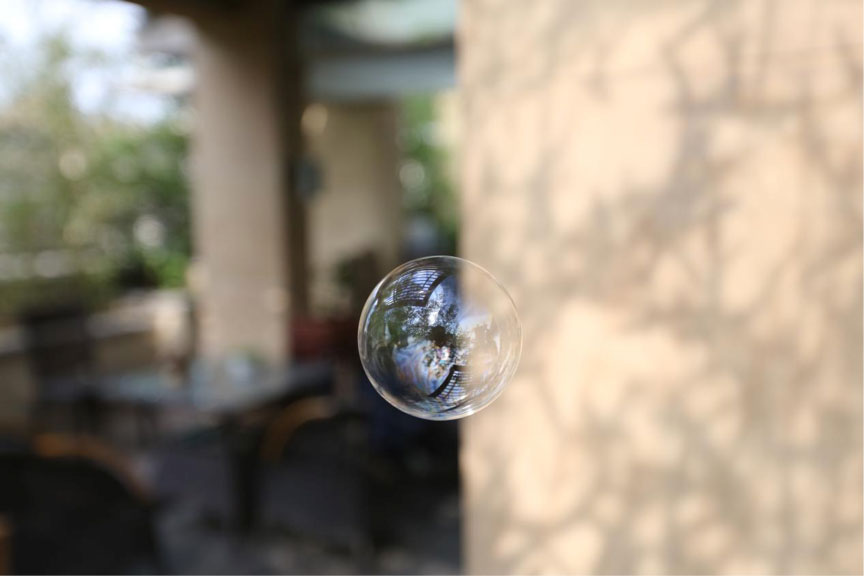
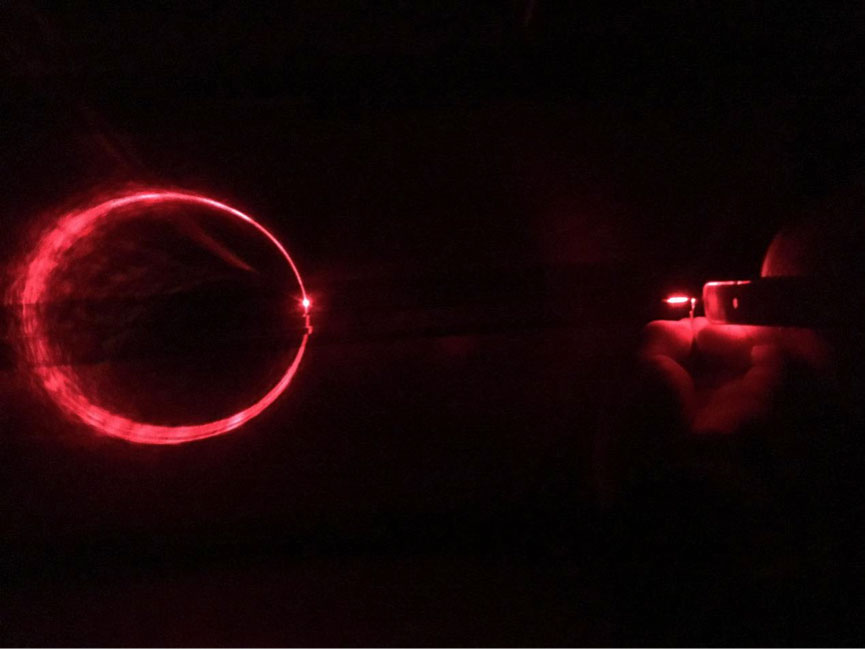
This photo demonstrates a light ring formed by aiming a laser at a metal wire. The amazing thing about the phenomenon is that this light ring consists both the effect from refraction and the effect from diffraction. The metal wire is a twisted paper clip and the part of paper clip encountering the laser is set straight. At first I had the metal wire vertical to the laser but only a line is observed. Then I discovered that with larger angle between laser and metal wire, the radius of light ring became greater. This relationship illustrates the involvement of refraction. Thus, in order to generate a light ring of a containable size for photographing, the smallest angle between it and the laser is set as an acute angle. This full and closing light ring can only be observed with the laser radius being larger than the radius of the metal wire. Such condition reflect the important role of diffraction. The lights reflected by the front part of metal wire form part of the light ring and the diffraction lights formed the other part of the light ring. Therefore, the light ring in this photo shows the marvelous cooperation of refraction and diffraction.
—— 39. Ziyi Wang
This photo explains concept of Propagation of light along a straight line. I cut paper to a certain shape consisted birds and flowers. Then, I lighted the paper with flashlight in a dark room. Since light goes in straight line, the place I have not cut would appear shadow, covering wall and bookcase. On the contrary, the place I have cut would be gone through light.
—— 43. Jiajing Zheng
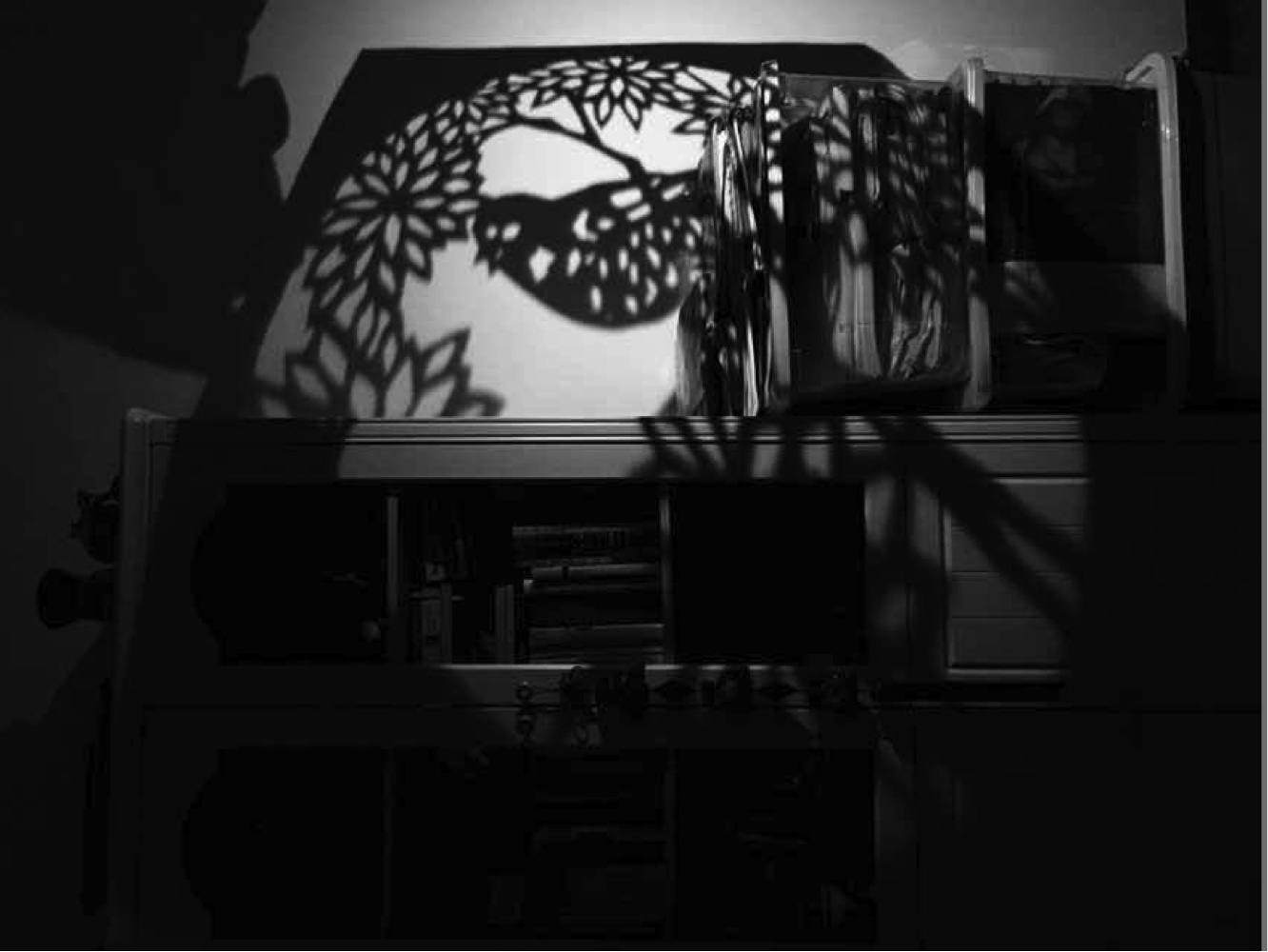
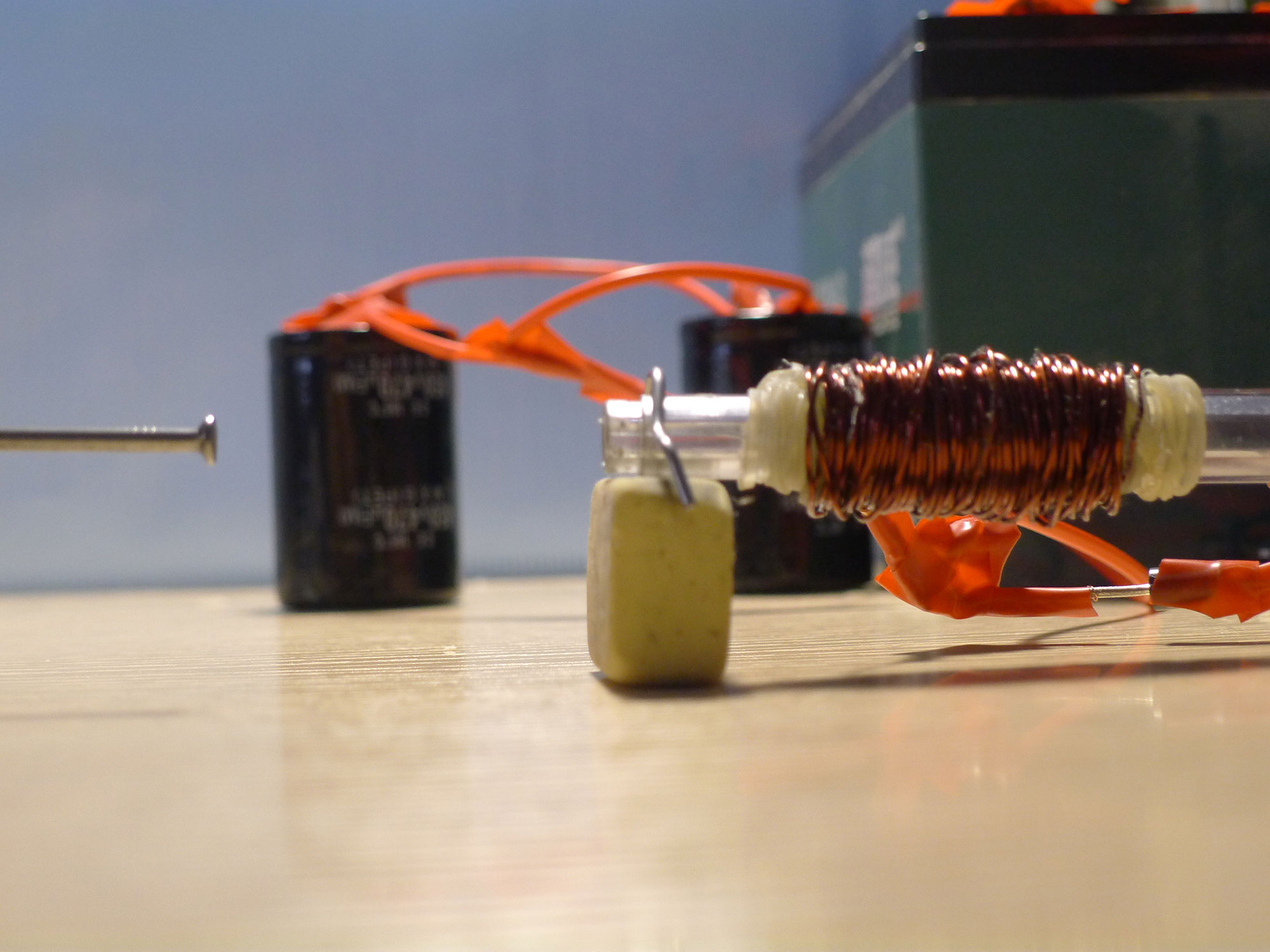
Driven by the magnetic field produced by the instantaneous direct current pulse of over 1,000 amperes flowing through a coil (effectively creating a electromagnet), the iron nail -- a ferromagnetic projectile -- flew straight out of the plastic barrel (from a ballpoint pen) towards its target with a muzzle speed of over 8m/s. The primary physical phenomenon showed in this coilgun, or “Gauss Gun” (named after the physicist Gauss who came up with the first mathematical explanation of the magnetic field) is electromagnetism -- that is, moving charges (in this case, currents) produces magnetic field that propels the iron projectile. This device, which is primarily a coil of varnished copper wire, is powered with the current from a 12V rechargeable battery from a electric bike, which is then raised to 450V by a ZVS circuit and stored in two 470 microfarad electrolyte capacitors in parallel. When the capacitor finished charging, the coil and the capacitors are then switched to directly connected in series, causing a quick discharge which then created a powerful short pulse of current through the coil.
—— 47. Annan Zou
Name of photo: The beauty of chopsticks.
This photo contains three physical phenomena that can be found easily in my daily life. Chopsticks function as a lever, two wider ends join together to act as a fulcrum; the effort is applied by thumb and middle finger with the assistance of index finger; the load is at the smaller tips. It is the friction that holds the grape. Also, since light spreads along a straight line in the same uniform medium, the shades of hand, chopsticks, and grape are projected on the wall.
—— 48. Linyue Wu


The phenomenon of friction electrification usually occurs in dry environments. A very illustrate example is when we use a plastic stick to rub our hair, our hair will stand on end with it, and more interestingly, if we put the rubbed plastic stick close to small pieces of paper, it will suck them up for a few seconds. So we say that this plastic stick gets the electrification by rubbing our hair so that it can suck light things up. More specifically, there are two different kinds of electric charges-positive and negative. This means, when negatively charged objects are near a conductor that has no charge, one side of the conductor which is near the objects will be charged with the positive electricity, on the contrary, the other side will be charged with the negative electricity because of the induction electrification. Therefore, though those small pieces of papers are not conductors, they will be charged under the action of an electric field. So, this scientific principle of triboelectrification can explain the phenomenon shown in the image I share.
—— 49. Mingxiu Han
In this photo, I took two stainless steel forks grouped together with a toothpick, which stands at the tip of another toothpick. First, make sure those two forks are tightly locked together, then a toothpick should be inserted into where the two forks are crossed, and try to make them stay firmly together. last, let this toothpick cross over and stand on the other tooth pick's tip which has already inserted in the iPad. Scientific principle: no matter how unstable the device looks, it is truly a ""stable equilibrium"". As shown in the image above, the centre-of-gravity of the combination coincides with that of the following upright toothpick, and it is below the fulcrum. If the pivot is above the center of gravity, it is called ""unstable equilibrium"". For example, when you stand things, if the contact surface is very small, it will collapse easily and if the pivot is below the center of gravity, it is ""stability balance"", just like the cases when you are hanging things.
So, this image perfectly demonstrate these two concepts of physics, ""stable balance"" and ""unstable balance.
—— 51. Ziheng Wang
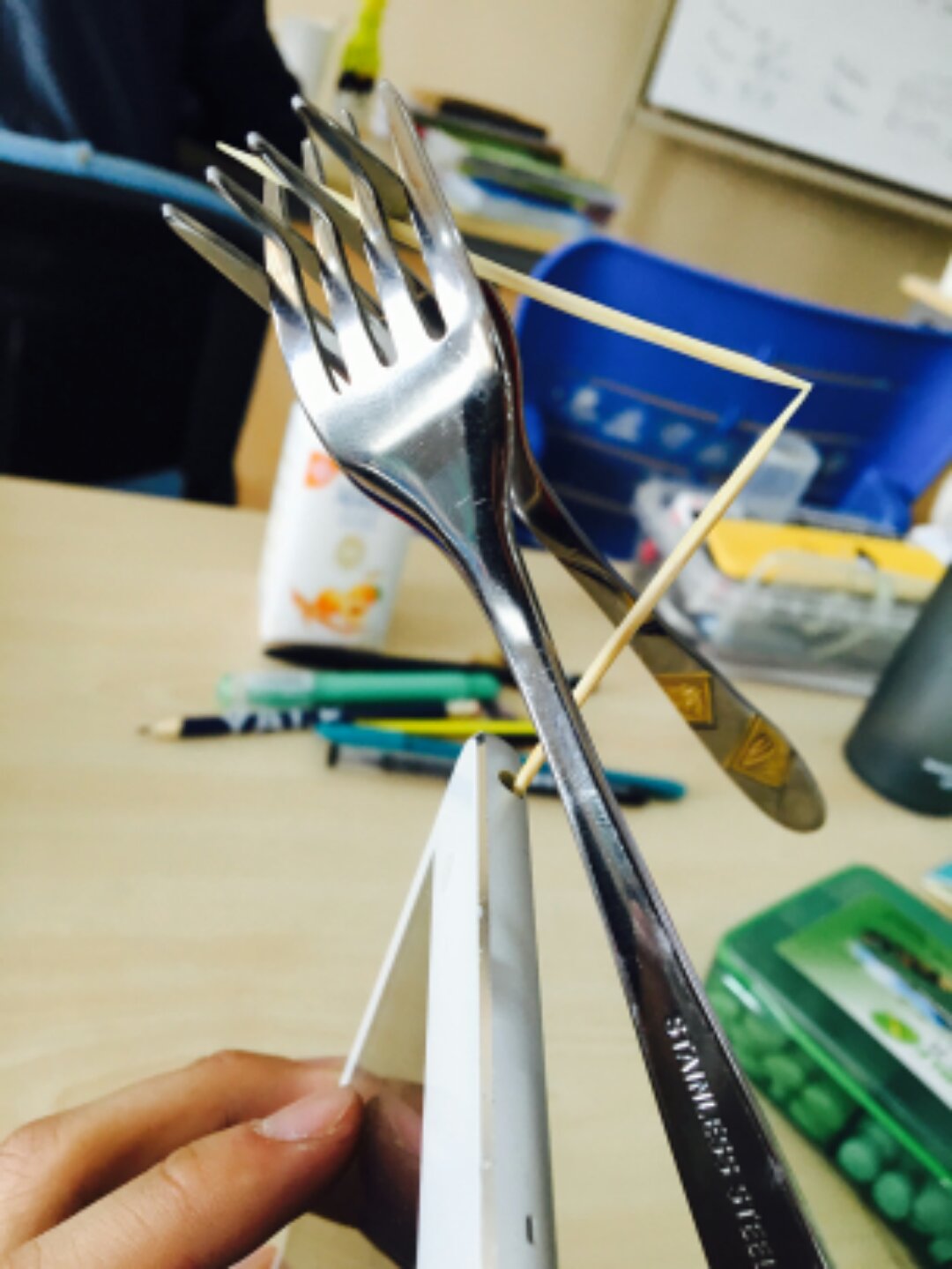
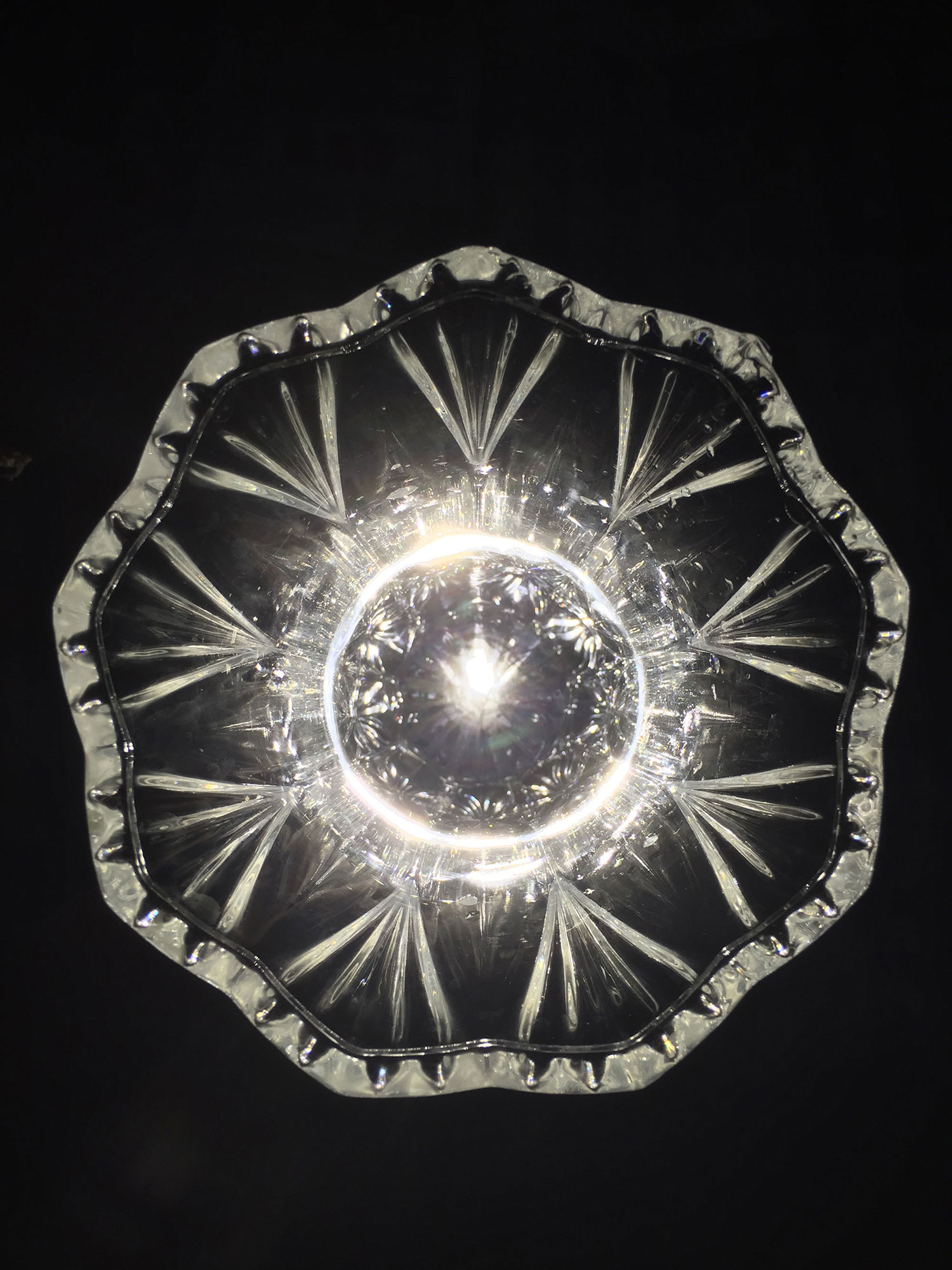
In this photo a flashlight is placed under a glass vase which has a larger opening top than bottom and the picture is taken right above the vase. The inner circle of the pattern is very bright because the reflection of light occurs on every side in the vase near the bottom. And the outside circle is darker. One reason for this is that the angle of the opening top does not allow it to reflect the flashlight. Another reason is that some light travels inside the glass by total internal reflection. When the light comes out of the glass, all the light from the darker area cannot be accepted by the camera since the surface is flat and smooth and most of the light comes out in one direction. However the area with the pattern, which corresponds to the curved area on the vase where the light comes out in a different direction, can be accepted by the camera. As for the outermost circle, it is the edge of the vase. The light reflects inside the glass and finally comes out with refraction from the edge.
—— 52. Qianqian Yang
Isn't physics magical? Even a small thing can demonstrate great strength by applying certain physical rules. In this picture, the fragile pieces of paper are able to hold nine bottles of water (about five kilograms). When two books are crossed together, the friction force between pages keeps the hanging objects from falling apart. What's more, hanging the books and bottles of water on the table requires only a thin stick. By applying the lever rule, I successfully used a wooden stick to fix the system and put only a book to keep it balanced.
—— 55. Zhenzhen Liu
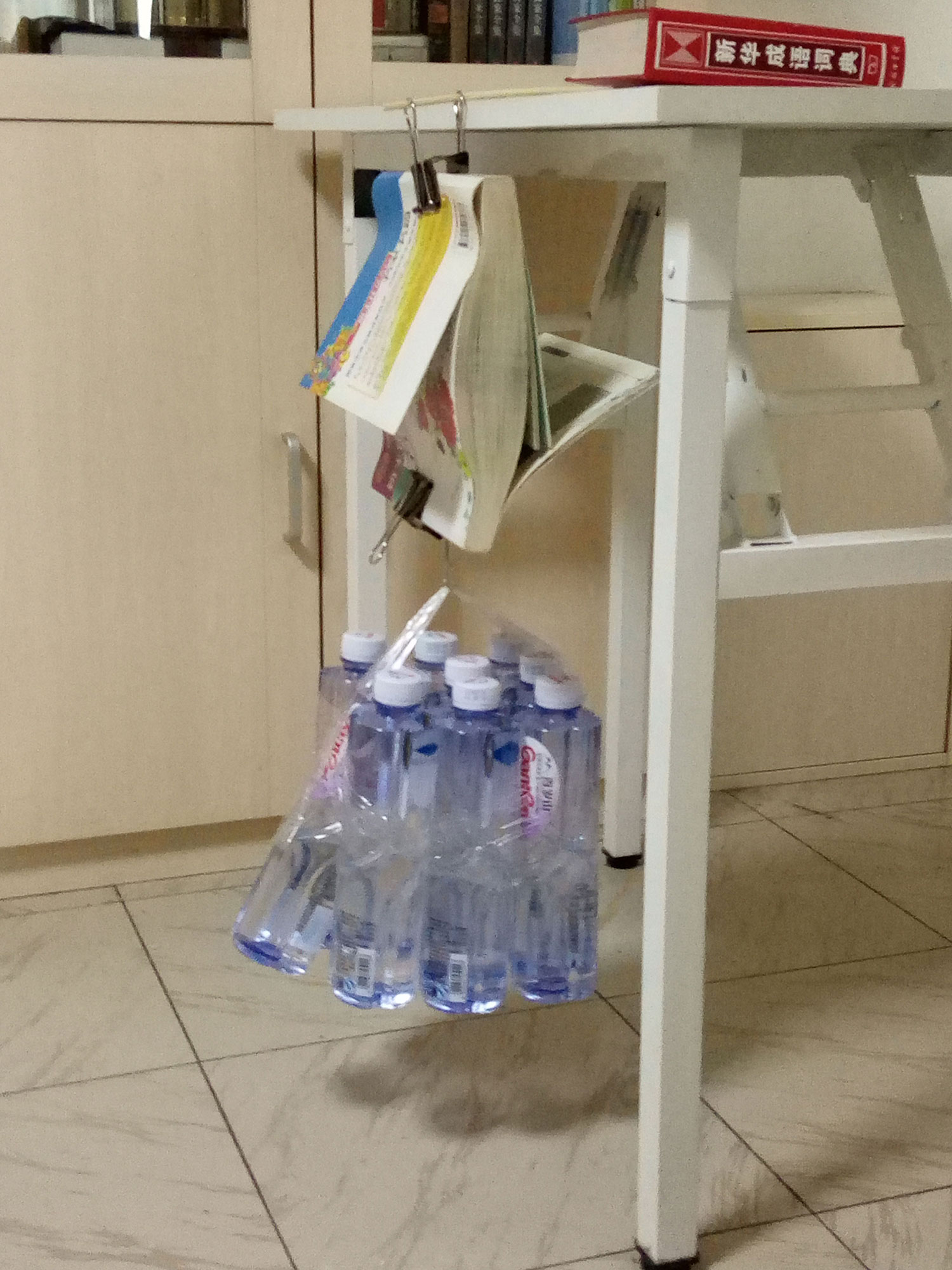
Winners
Natural photos
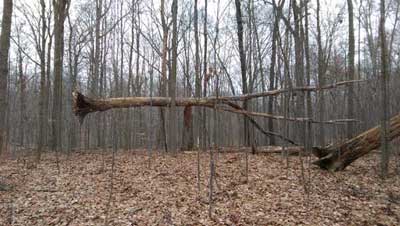
This photo demonstrates the principles of center of mass, as a fallen tree has balanced itself across the stump of another. How the tree fell is unknown, but one can see how the weight is distributed evenly across the stump. With more of the tree’s length on the right side to balance out the greater girth, and therefore mass, on the left with the base of the tree. The physics behind the phenomenon is ultimately simple. The force due to gravity on either side of the pivot is equal. Due to the nonuniformity of the tree, the center of mass is clearly not the geometric center and could be calculated with simple calculus should the total mass and density of the tree be known.
——the first prize in 2017
The world is a beautiful place full of natural phenomena that can be explained by simple physics. I took this picture on my flight to France about a year ago. The shadow in the clouds seen in this image comes from light being blocked by the plane, since light cannot bend to get around objects. The rainbow surrounding the shadow of the plane is caused by total internal reflection in the water droplets and dispersion that separates white light into its component colors. These colors and their order represent visible light on the electromagnetic spectrum. Since red has the longest wavelength, it is at the top of the rainbow, and since violet has the shortest wavelength, it is at the bottom of the rainbow. The reason why we can see this rainbow is that the sun is behind the plane, and there are water droplets in front of the plane. As seen in this photograph, rainbows are actually perfect circles. When we typically see rainbows they are in the shape of an arc because the ground keeps the circle from being completed. We truly do live in a wonderful world.
——the second prize in 2015
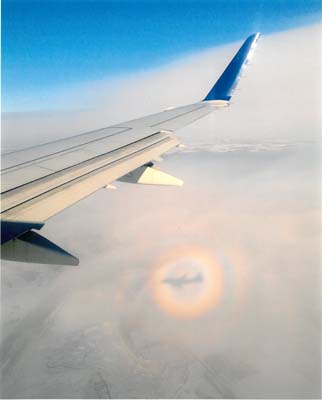
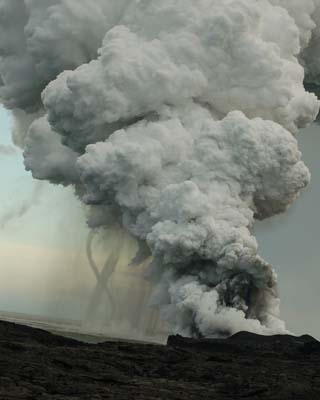
In the picture that I have taken it can clearly be seen that there are 2 waterspouts that originated from the volcanic steam. This is due to the mixture of the hot volcanic steam and the cool air from the oncoming rainstorm. The hot and cold air spiral down in rotational motion and creates the water spouts. There is all fluid dynamics involved as the high and low pressure air also cause rotational motion downwards as well. This then caused a vortex to form out of the volcanic cloud which then became the water spout.
——the third prize in 2015
This photo demonstrates the idea of centripetal force. Water pumped out by the elephant holds a circular shape against gravity. The combination of force from the elephant?s lungs, the path of its truck, and the angle of the tip of the truck resulted in a centripetal force that pulls the water molecules together inward to create a circular swirl shape. Because the centripetal force at that moment is greater than the gravitational force of the earth, the shape is maintained instead of the swirl shape falling apart and the water splashing downward. This photo was taken in Chitwan, Nepal.
——the second prize in 2014

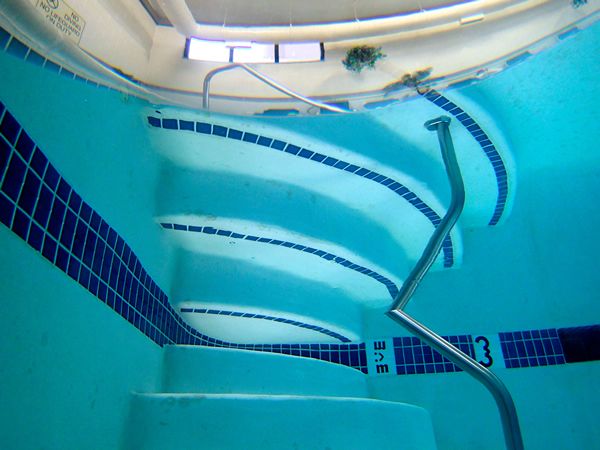
This photograph of stairs in a pool, taken from an underwater perspective, demonstrates the critical angle, the angle of incidence that produces a refracted light ray parallel to the boundary between the water and the air. Light rays with angles of incidence that are less than the critical angle are refracted as they cross the boundary between the two media, which is why the handrail appears to be distorted. Alternatively, light rays with angles of incidence greater than the critical angle aren't refracted at all and instead are totally reflected back into the water. In this way, the surface of the water acts as a mirror.
——the first prize in 2013
This image was taken over a 45-day exposure using a paint-can pinhole camera. As the sun moves across the sky, it burns an image into the photopaper placed inside the paint can. Each streak corresponds to a day and the gaps or incomplete streaks are caused by overcast weather that day. This technique is called solargraphy. Over longer exposures it is possible to see how the height of the streak changes in relation to the seasons. The streaks are not perfect arcs because of the warped nature of the photopaper while wrapped up in the paint can. All that is required besides a pin hole camera is black and white photosensitive paper. Oddly, not only is the final exposure in color, but it doesn?t even have to be developed. The negative was scanned, horizontally flipped, the colors inverted, and here it is! The presence of color is due to the degradation of the chemicals in the photopaper.
——the third prize in 2009
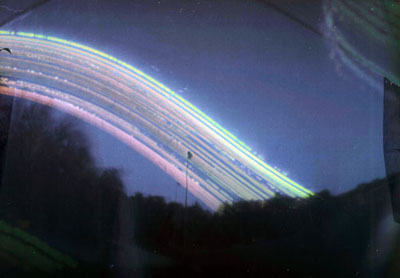
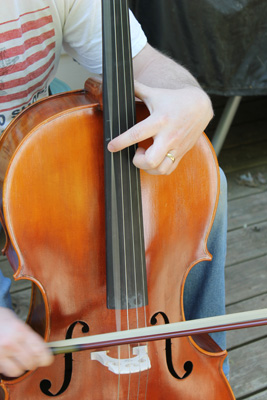
This picture depicts a standing wave at the second harmonic forming when someone is playing the lowest string (C) on a cello. The person's finger is touching exactly the middle of the string on a node. Nodes are also formed at the ends of the string because they are fixed ends. Nodes are places were there is no displacement from the equilibrium position (no movement). Antinodes are places that are moving and look blurry in the picture. There are two antinodes on the string because it is at the second harmonic. The note being played is the same as if the string were not being touched at all, just an octave higher because the frequency is twice as high at the second harmonic than it is at the fundamental frequency.
——the third prize in 2013
Contrived photos
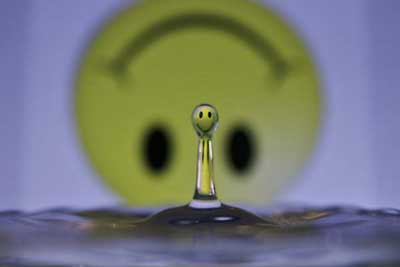
This is a photo of a droplet of as it splashed out of a small container of water. There are two things happening. First, the attraction between water molecules allows water to form spherical droplets. This, in turn, creates the second concept, a lens effect. The water droplet acts as a converging lens. As light transfers from one medium to another, air to water, the light encounters a change in density. This change in density, along with the curved surface of the drop, cause the light to change direction. Light transferring from the air to the water drop refracts towards the normal to the surface. It then continues in a straight path to the other side of the droplet. Again, it encounters a boundary between densities. But this time, as light travels from water to air, it refracts away from the normal to the surface. This bending of light creates a focal point that is between the drop and the camera, resulting in a negative focal length, showing an inverted and smaller image. Doesn’t physics just make you smile?
——the first prize in 2017
In this photo I have balanced a combination of coins on top of each other to create a bridge across two blocks. I started by placing a nickel about one third of the way off both blocks. I then stacked coins continually on top of these until they met in the middle. I had to place stacks of pennies on top of the nickels to retain static equilibrium, the physical state when the net force of an object is equal to zero throughout its whole. This means the bridge is stable and will not collapse. I have acquired this state through the careful balancing of the coins. The center of mass, the center point at which all vectors add up to zero, is typically at the center of a bridge. In my coin bridge, it would be somewhere in the center of the middle penny stack. These two concepts of physics, static equilibrium and center of mass, create the balance my coin bridge requires.
——the first prize in 2015
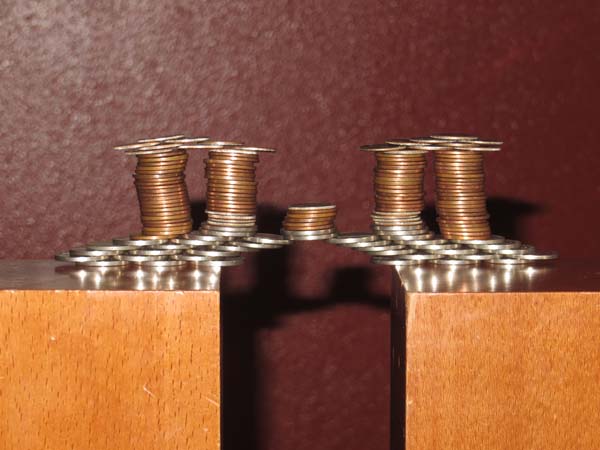
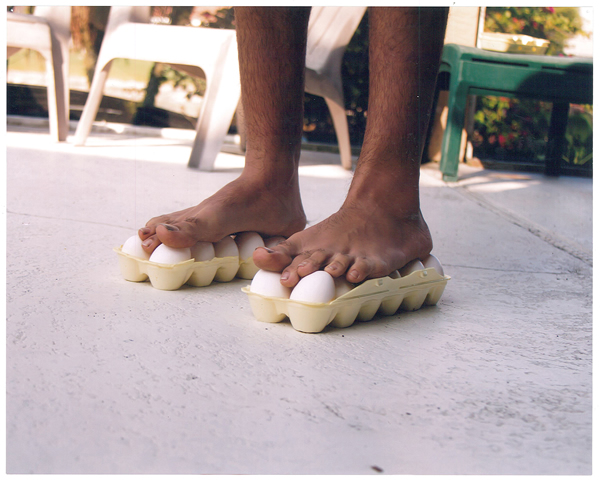
This is a picture of my friend Samer, standing on two cartons of eggs. Most people think of eggs as being very fragile, but this is not the case. Just like in bridges and building, eggs utilize the strongest shape there is: the arch. Eggs have shapes that are unique and similar to a 3 dimensional arch. An egg?s strength lies at the top and bottom. When a force is applied to these locations, the pressure is distributed all around the egg. Alternatively, when a force is applied to the side of the egg, for instance, cracking an egg on the side of a bowl, the pressure is concentrated at that point. All of the eggs are pointing up in the carton which is why Samer is able to stand on them without them breaking. Samer?s weight (the force) is distributed evenly over the ?arch? of each egg. If the eggs were not all placed in the same facing directions, the yoke would have been on us.
——the second prize in 2013
For this photo, I stacked some of my favorite books on top of a small candle into the shape of a heart. The stack of books began with three books directly on top of each other, placed on top of the candle so that the candle supported the three books under their center of mass. This set-up is similar to that of the lever, with the candle being the fulcrum and the three stacked books being the bar. In order to have the stack of books remaining at a state of static equilibrium, additional books were then added to the stack two at a time, one on each side of the candle, with both books having approximately equal masses so that the candle continues to be under the stack?s center of mass. This also ensures that the force of the books on either side of the candle are equal, creating a net force of 0N and keeping the acceleration of the stack at 0m/s^2. With this method, the heart will not break.
——the third prize in 2013
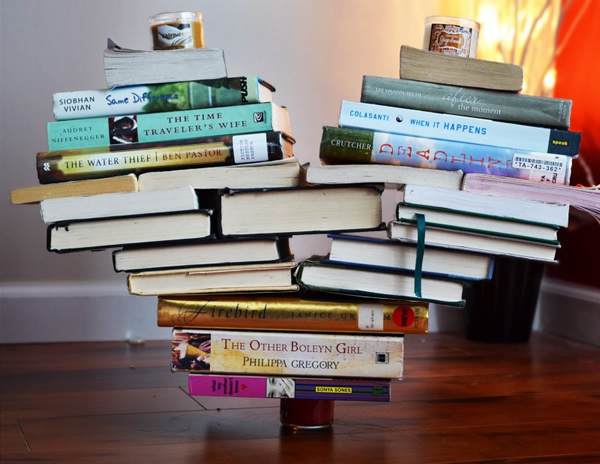
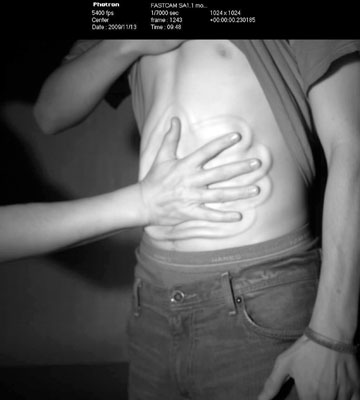
Using a high speed camera, the instant of a hand slapping a stomach was captured. This activity caused a shockwave that originated at the hand to move across the stomach. This shockwave is in the shape of the hand. The shockwave was created by the transfer of energy from the hand to the stomach. The kinetic energy from the hand was transferred to the skin of the stomach and moves across the torso of the body.
——the first prize in 2010
This is a picture of Pringles stacked together to form a ring. Beginning with a single Pringles chip, I started stacking more chips on top of it. This is similar to a lever, where the first chip acts as the fulcrum and the second and third chips are the beam. The next chips have to be stacked on each side of the lever equally so that the Pringles are at static equilibrium. Since each side of the lever has the same amount of chips with equal mass, the first chip is under all the other chips, and both sides of the lever have the same amount of force, resulting in a net force of 0N. With the use of a lever and Pringles uniquely shaped chips, a delicious ring of Pringles can be formed.
——the third prize in 2014
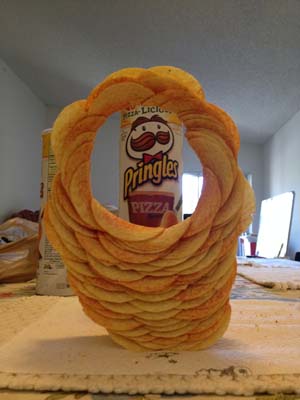
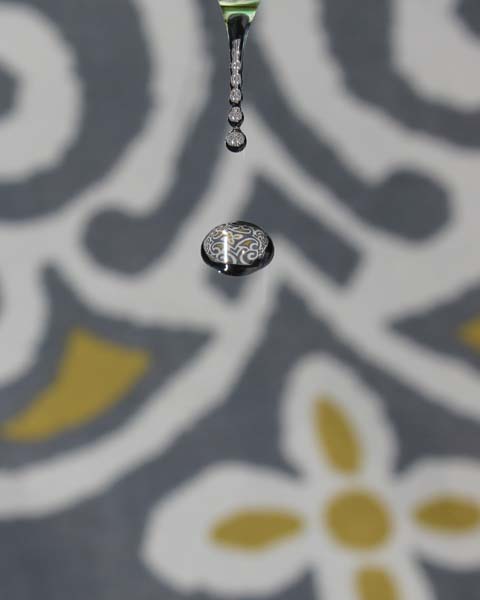
Optical light refraction is demonstrated in this photograph of a water droplet. To take this picture, I placed a piece of fabric behind a sink faucet, and then captured this image of a single water droplet as it passed in front of the cloth. The droplet displays a version of the cloth that appears to be curved. This curve is caused by refraction: the traveling light passed through a different medium (water), and its speed changed from what it had been when traveling through the previous medium (the air outside of the water droplet). The water was more dense than the air so it caused the light to pass through it at a slower speed. This change in the light's speed caused it to have a shorter wavelength. This along with the slower speed caused the path of the light to bend which is what caused the cloth appear to be curved.
——the second prize in 2015
ASDAN EPQ Scholarship
3000RMB/std
The first prize
2000RMB/std
The second prize
1000RMB/std
The third prize
Noted:The ASDAN Scholarship is only available to Year 10, 11 and 12 students for participating ASDAN Extended Project Qualification(EPQ). EPQ is recommended by the G5 group and many leading universities as a competitive academic experience. Scholarships cannot be exchanged for cash. For further details see:http://www.seedasdan.org/epq/。





















